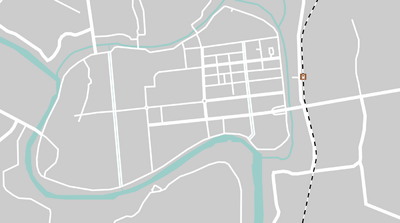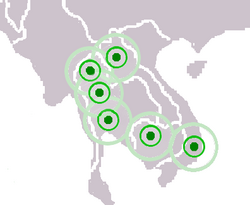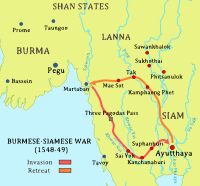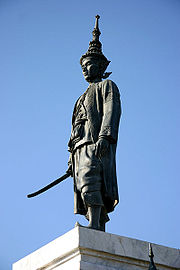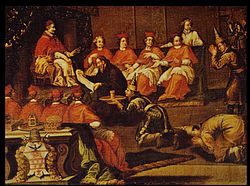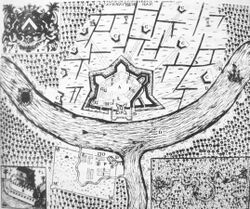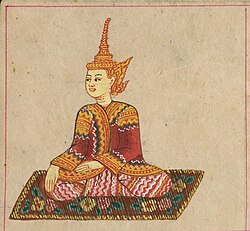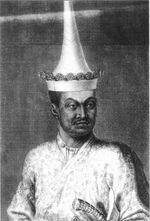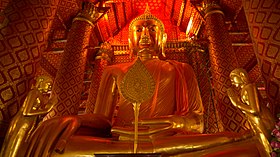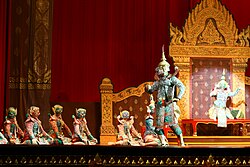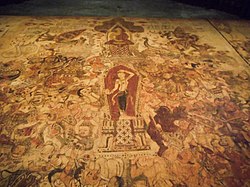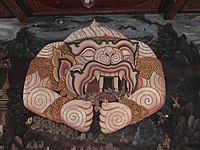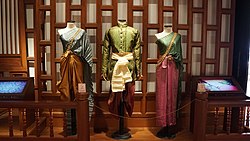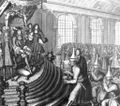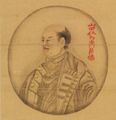Ayutthaya Kingdom
Topic: History
 From HandWiki - Reading time: 67 min
From HandWiki - Reading time: 67 min
Ayutthaya Kingdom อาณาจักรอยุธยา Anachak Ayutthaya | |||||||||||||||||||||
|---|---|---|---|---|---|---|---|---|---|---|---|---|---|---|---|---|---|---|---|---|---|
| 1351[1]–1767 | |||||||||||||||||||||
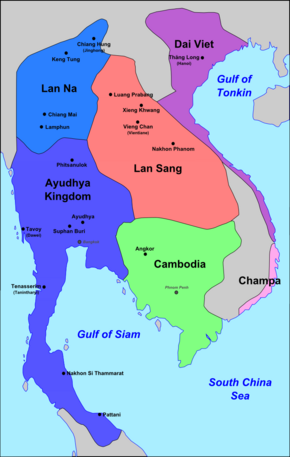 Ayutthaya and Mainland Southeast Asia in 1540. Note: Southeast Asian political borders remained relatively undefined until the modern period. | |||||||||||||||||||||
![The Ayutthaya Kingdom's sphere of influence in 1605, following the military campaigns of King Naresuan.[2]](https://handwiki.org/wiki/images/thumb/8/87/Ayutthaya_Map_in_1605.png/290px-Ayutthaya_Map_in_1605.png) The Ayutthaya Kingdom's sphere of influence in 1605, following the military campaigns of King Naresuan.[2] | |||||||||||||||||||||
| Capital | Template:Ubil | ||||||||||||||||||||
| Common languages | Template:Ubil | ||||||||||||||||||||
| Religion | Majority: Theravada Buddhism Minority: Hinduism, Roman Catholic, Islam | ||||||||||||||||||||
| Government | Mandala kingship | ||||||||||||||||||||
| King | |||||||||||||||||||||
• 1351–1369 | Ramathibodi I (first) | ||||||||||||||||||||
• 1448–c. 1488[3] | Borommatrailokkanat | ||||||||||||||||||||
• 1590–1605 | Naresuan | ||||||||||||||||||||
• 1605–1610/11 | Ekathotsarot | ||||||||||||||||||||
• 1629–1657 | Prasat Thong | ||||||||||||||||||||
• 1657–1688 | Narai | ||||||||||||||||||||
• 1733–1758 | Borommakot | ||||||||||||||||||||
• 1758–1759/60,[4] 1762–1767 | Ekkathat (last) | ||||||||||||||||||||
| Viceroy | |||||||||||||||||||||
• 1438–1448 | Ramesuan (first) | ||||||||||||||||||||
• 1757–1758 | Phonphinit (last) | ||||||||||||||||||||
| Legislature | None | ||||||||||||||||||||
| History | |||||||||||||||||||||
• Establishment | 4 March 1351[1] | ||||||||||||||||||||
• First tribute embassy to China | 1292[note 1][5] | ||||||||||||||||||||
• Seaborne invasions of the Malay Peninsula and Sumatra | 1290s–1490s[6] | ||||||||||||||||||||
• Lopburi–Suphanburi rivalry | 1370–1409 | ||||||||||||||||||||
• Political merger with the Northern Cities[note 2] | 1370s–1569[2] | ||||||||||||||||||||
• Vassal of the Taungoo dynasty | 1564–1568, 1569–1584 | ||||||||||||||||||||
• Golden Age | 1605–1767[2] | ||||||||||||||||||||
• Qing dynasty's revocation of private trade ban | 1684 | ||||||||||||||||||||
• Konbaung invasions | 1759–60, 1765–67 | ||||||||||||||||||||
• Dissolution | 7 April 1767 | ||||||||||||||||||||
| Population | |||||||||||||||||||||
• c. 1600[7] | ~2,500,000 | ||||||||||||||||||||
| Currency | Pod duang | ||||||||||||||||||||
| |||||||||||||||||||||
| Today part of | |||||||||||||||||||||
The Ayutthaya Kingdom (/ɑːˈjuːtəjə/; Thai: อยุธยา, RTGS: Ayutthaya, IAST: Ayudhyā or Ayodhyā, pronounced [ʔā.jút.tʰā.jāː] (![]() listen)) or the Empire of Ayutthaya[9] was a Siamese kingdom that existed in Southeast Asia from 1351[1][10][11] to 1767, centered around the city of Ayutthaya, in Siam, or present-day Thailand. European travellers in the early 16th century called Ayutthaya one of the three great powers of Asia (alongside Vijayanagar and China).[1] The Ayutthaya Kingdom is considered to be the precursor of modern Thailand, and its developments are an important part of the history of Thailand.[1]
listen)) or the Empire of Ayutthaya[9] was a Siamese kingdom that existed in Southeast Asia from 1351[1][10][11] to 1767, centered around the city of Ayutthaya, in Siam, or present-day Thailand. European travellers in the early 16th century called Ayutthaya one of the three great powers of Asia (alongside Vijayanagar and China).[1] The Ayutthaya Kingdom is considered to be the precursor of modern Thailand, and its developments are an important part of the history of Thailand.[1]
The Ayutthaya Kingdom emerged from the mandala/merger of three maritime city-states on the Lower Chao Phraya Valley in the late 13th and 14th centuries (Lopburi, Suphanburi, and Ayutthaya).[12] The early kingdom was a maritime confederation, oriented to post-Srivijaya Maritime Southeast Asia, conducting raids and tribute from these maritime states. After two centuries of political organization from the Northern Cities and a transition to a hinterland state, Ayutthaya centralized and became one of the great powers of Asia. From 1569 to 1584, Ayutthaya was a vassal state of Taungoo Burma, but quickly regained independence. In the seventeenth and eighteenth centuries, Ayutthaya emerged as an entrepôt of international trade and its cultures flourished. The reign of Narai (r. 1657–1688) was known for Persian and later, European, influence and the sending of the 1686 Siamese embassy to the French court of King Louis XIV. The Late Ayutthaya Period saw the departure of the French and English but growing prominence of the Chinese. The period was described as a "golden age" of Siamese culture and saw the rise in Chinese trade and the introduction of capitalism into Siam,[13] a development that would continue to expand in the centuries following the fall of Ayutthaya.[14][15]
Ayutthaya's failure to create a peaceful order of succession and the introduction of capitalism undermined the traditional organization of its elite and the old bonds of labor control which formed the military and government organization of the kingdom. In the mid-18th century, the Burmese Konbaung dynasty invaded Ayutthaya in 1759–1760 and 1765–1767. In April 1767, after a 14-month siege, the city of Ayutthaya fell to besieging Burmese forces and was completely destroyed, thereby ending the 417-year-old Ayutthaya Kingdom. Siam, however, quickly recovered from the collapse and the seat of Siamese authority was moved to Thonburi-Bangkok within the next 15 years.[14][16]
In foreign accounts, Ayutthaya was called "Siam", but many[which?] sources say the people of Ayutthaya called themselves Tai, and their kingdom Krung Tai (Thai: กรุงไท) meaning 'Tai country' (กรุงไท). It was also referred to as Iudea in a painting requested by the Dutch East India Company.[note 3] The capital city of Ayutthaya is officially known as Krung Thep Dvaravati Si Ayutthaya (Thai: กรุงเทพทวารวดีศรีอยุธยา), as documented in historical sources.[17][18][19][20]
History
Origins
The lower Chao Phraya Basin around the turn of the second millennium was split between Lavo Kingdom, which dominated the eastern half of the Lower Chao Phraya, and the Suphanburi (Suvarnabhumi), which dominated the west. The lower Chao Phraya Basin was also influenced by Angkorian culture but not direct Angkorian political and military influence.[16][2] Ayutthaya, argued by Charnvit Kasetsiri, was the merger of four different port polities along the Lower Chao Phraya Basin: Lopburi (Lavo),[21] Suphanburi, Ayutthaya, and Phetchaburi. Suphanburi had first sent a tribute mission to Song dynasty in 1180 and Phetchaburi to the Yuan dynasty in 1294 and tribute missions to Vijaynagar empire between 1400-1500 [22][12][23]
The city of Ayutthaya is likely to have existed before the supposed "foundation" in 1351. Archaeological findings have found evidence of buildings on the island of Ayutthaya prior to the 12th century. Pottery shards have been discovered to have been dated as early as the 1270s. Some temples to the east of Ayutthaya, off the island, have been known to exist before 1351.[12] Recent archaeological works reveal pre-existing barays superimposed on by subsequent structures. The Tamnan mulasasana Buddhist chronicle notes that in the 1320s, two Buddhist monks visited Ayutthaya in search of scriptures and that a previous monk had been honored by the "King of Ayodhia" on his return from Lanka.[24] Since the late 13th century, expeditions were sent to the Malay peninsula and Sumatra in the goal of extracting resources to gain a share of the maritime trade.[25] Other contemporary scholars argued that Ayutthaya had been an important commercial center since the 11th century or at least several centuries prior to 1351.[26]
The earliest written records of Ayutthaya in the Chinese chronicles is that a Chinese official fled to Xian in 1282/83. Xian first sent an embassy to China in 1292, who the Chinese then requested another embassy soon after that, signifying Ayutthaya's early prominence before Ayutthaya's founding. While older and traditional scholars argue that the ethnically Thai Sukhothai or Suphanburi was the Xiān[27][22] mentioned in Chinese sources, more recent scholarship, like Chris Baker and Pasuk Phongpaichit, argue that Xian referred to Ayutthaya as that was the same name later used for Ayutthaya by the Chinese court. Michael Vickery argued that it is likely the Chinese used Xian to refer to the lower Chao Phraya Basin from its inception.[12][26]
Pre-Ayutthaya cities
In 877, a royal lineage from Bang Pan (present-day in Phran Kratai, Kamphaeng Phet), Phra Maha Buddha Sakorn (พระมหาพุทธสาคร), founded a new city named Sangkaburi (สังขะบุรี) on the south bank of Lopburi River near the present-day Wat Thammikarat (th).[28] Sakorn ruled the city for 97 years until he died in 974 and the throne was then transferred to another royal lineage from Inthapatnakhon (อินทปัตนคร), Phraya Khodhom (พระยาโคดม), who then relocated the city eastward to the right bank of Pasak River near the present Wat Ayodhya (th), and the old city Sangkaburi was abandoned.[29]
Khodhom ruled the new city for 30 years then his son, Kothrabong (โคตรบอง), took over the throne in 1004.[30] Later in 1022, Kothrabong lost power to Kreak (แกรก), a commoner from Lavo, who was then crowned as the new ruler named Sinthapomarin (สินธพอมรินทร์).[31] Because Kreak was not originally considered a royal lineage, after he died in 1081, the throne was despoiled by Narai, the son of King Chadachota from Lavo Kingdom, who was of the lineage of the previous Sangkaburi's kings.[32] Narai renamed the city Ayodhya (อโยธยา) and eventually set it as the new capital of the Lavo Kingdom during his reign.[32][33] The former capital was then renamed Lopburi.[34]
After the end of Narai's reign in 1147, Ayodhya fell under the power struggles between nine amatyas for two years,[34] until the throne was given to Phra Chao Luang (พระเจ้าหลวง), who relocated the city, in 1157, southward to the east bank of the Chao Phraya River near the mouth of the Mae Bea River (แม่น้ำแม่เบี้ย), south of the present Wat Phanan Choeng.[35] The new city was later named Sena Ratchanakhon (เสนาราชนคร) by his successor, Duangkrien Kritnarat (ดวงเกรียนกฤษณราช) or Sai Nam Peung who was appointed the new ruler by his father, Kraisornrat (ไกรสรราช) who was also the Lopburi's king.[36][37] The city of Ayodhya was abandoned in 1211.[37]
After Lopburi's King Kraisornrat died with no heir apparent, the king of Phraek Siracha (present-day Sankhaburi), who was the grandfather of Ayutthaya's first king, Uthong, took over the throne. After he died in 1319, both Lopburi and the city of Sena Ratchanakhon was considered royal inheritances for his daughter, who later passed it to her son, Uthong.[38]
| ||||||||||||||||||||||||||||||||||||||||||||||||||||||||||||||||||||||||||||||||||||||||||||||||||
| ||||||||||||||||||||||||||||||||||||||||||||||||||||||||||||||||||||||||||||||||||||||||||||||||||
| Sangkaburi (877-974) |
Ayodhya (974-1211) |
Sena Ratchanakhon (1157-1388) | ||||||||||||||||||||||||||||||||||||||||||||||||||||||||||||||||||||||||||||||||||||||||||||||||
| Buddha Sakorn | Khodhom | Kothrabong | Kreak | Narai | Vacant | Luang | Sai Nam Peung | Dhammikaraja | Uthong[α] | |||||||||||||||||||||||||||||||||||||||||||||||||||||||||||||||||||||||||||||||||||||||||
| (r.877-974) | (r.974-1004) | (r.1004-1022) | (r.1022-1081) | (r.1081-1147) | (1147-1149) | (r.1149-1211) | (r.1211-1252) | (r.1252-1347) | (r.1347-1369) | |||||||||||||||||||||||||||||||||||||||||||||||||||||||||||||||||||||||||||||||||||||||||
| Dvaravati Kingdom | Lavo Kingdom | |||||||||||||||||||||||||||||||||||||||||||||||||||||||||||||||||||||||||||||||||||||||||||||||||
| Note: ^α Also the first king of Ayutthaya Kingdom. | ||||||||||||||||||||||||||||||||||||||||||||||||||||||||||||||||||||||||||||||||||||||||||||||||||
The traditional founding of Ayutthaya
Ayutthaya was traditionally founded by King Uthong on 4 March 1351.[40] This fact, however, has been subject to long scholarly debate. According to Chris Baker-Pasuk Phongpaichit, there are at least seven legends about who Uthong was: "a Northern Thai prince, a fugitive Chinese prince from the sea, a Khmer noble from Angkor, a ruler from one of the gulf cities, or a Chola."[41] Other than being the legendary founder of Ayutthaya, the only thing known about Uthong in the chronicles is the year of his death.[12]
Early maritime dominance

In the 1290s through to the 1490s, Ayutthaya sent forces down to the peninsula and demanded tribute from the Malay principalities all the way down to Temasek (modern Singapore) and Sumatra. The early Ayutthaya polity was a maritime-oriented confederation, more in line with the Malay polities of Maritime Southeast Asia than with states inland like Sukhothai and the Northern Cities. Muslim and European mapmakers labelled the Malay peninsula up to the Tenasserim coast as part of Ayutthaya in the 15th and early 16th centuries. Early Ayutthaya did not keep records and their early dynastic chronology is likely fabricated by later Ayutthaya elites writing their past histories: the early chronology in the palace chronicles does not correlate with the Ayutthaya temple chronicles nor the Chinese court chronicles.[2][8][43]
The integrity of the patchwork of cities of early Ayutthaya Kingdom was maintained largely through familial connections under the mandala system.[44] King Uthong had his son, Prince Ramesuan, the ruler of Lopburi (Lavo),[21] his brother, the ruler of Praek Sriracha[45](in modern Chainat Province) and his brother-in-law, Khun Luang Pa-ngua, the ruler of Suphanburi. The ruler of Phetchaburi was his distant relative.[46] The king would appoint a prince or a relative to be the ruler of a city, and a city that was ruled by a prince was called Muang Look Luang (Thai: เมืองลูกหลวง). Each city ruler swore allegiance and loyalty to the King of Ayutthaya but also retained certain privileges.
Politics of Early Ayutthaya was characterized by rivalries between the two dynasties; the Uthong dynasty based on the Khmers of Lopburi (Lavo)[21] and the Suphannabhum dynasty based on the Mons of Suphanburi. Traditional narratives argued that Ayutthaya conquered Sukhothai, Angkor, etc, but more modern narratives argue that territorial conquest was a European thing and not a Southeast Asian thing. Rather, the processes which saw Ayutthaya expand was one of political merger and consolidation between the cities at the head of the peninsula and slowly ascending up the Chao Phraya River Basin to the Northern Cities.[12][47]
The culture of early Ayutthaya, described by Ma Huan, a scribe on Zheng He's voyages, in the early 15th century, described Ayutthaya as a rowdy port town, whose men practice fighting on water, and where the affairs of everyday life was arranged by the women. The cities on the peninsula regularly complained to the Chinese court about constant Siamese attacks down the peninsula around this time period.[12][47][48]
Age of warfare
The 1430s through to 1600 marked a period of rising warfare throughout Mainland Southeast Asia. In 1500, the Portuguese noted that Ayutthaya had 100 elephants, 50 years later, Ayutthaya had 50,000 elephants. Ayutthaya began launching military land expeditions far to the west and east. In the west, Ayutthaya fought to acquire the cities of Tavoy, Mergui, Tenasserim, and Martaban in the late 15th century. Song China's increasing interests to sea commerce at the turn of the second millennium made trade between China and the Indian Ocean especially lucrative. In the 1430s, Ayutthaya attacked Angkor, but did not sack the city, although Ayutthaya did install a short-lived puppet ruler.[12][47]
Palace Law Codes under Trailokkanat exemplified the newfound attention to warfare, citing a number of rewards for the number of enemies beheaded. The introduction of elephants, guns, and mercenaries made wars in Southeast Asia much more chronic and much more deadly. By the late 16th century, Pegu (Bago) suffered a severe conscript revolt, Ayutthaya phrai fled into the forests or bribed the conscription officers, and the construction of sturdier and stronger city walls made warfare largely ineffective.[12][47]
Transition to a hinterland state
The Ayutthaya Kingdom shifted from a maritime state to more of a hinterland state during the 15th and 16th centuries. Its absorption of the Northern Cities and the shifting of trade power to the inland trade routes with China facilitated this change of policy. The reign of King Borommatrailokkanat was the peak of this merger between the basin and the Northern Cities, being the scion of generations of intermarriage between the two.[12][47]
Even though Trailokkanat symbolized the merger between North and South, the Lan Na Kingdom, a state North of Ayutthaya (modern-day Northern Thailand), contested Ayutthaya's growing influence over the Northern Cities. The Ayutthaya-Lan Na War was fought over the Upper Chao Phraya valley for control of the Northern Cities. Whether he preferred the Northern Cities to Ayutthaya or the necessity to have a capital closer to the war, Trailokkanat moved his capital to Phitsanulok. Lan Na suffered setbacks and Trailokkanat eventually sued for peace in 1475.[12]
Ayutthaya's sphere of influence down the peninsula was contested by the Malacca Sultanate. Ayutthaya launched several abortive conquests against Malacca which was diplomatically and economically fortified by the military support of Ming China. In the early-15th century the Ming admiral Zheng He established a base of operation in the port city, making it a strategic position the Chinese could not afford to lose to the Siamese. Under this protection, Malacca flourished, becoming one of Ayutthaya's great foes until the capture of Malacca by the Portuguese.[49] Ayutthaya's attention to the portage routes across the upper peninsula meant that it did not send a military expedition to the lower peninsula and the Malay States throughout the 16th century.
Centralization and dominance of the Northern lords
Ayutthaya's sphere of influence was now stretched from the Northern Cities to the Malay Peninsula, with its heartland centered around the old Ayutthaya-Suphanburi-Lopburi-Phetchaburi polity. The Muang Look Luang system was inadequate to govern relatively vast territories. The government of Ayutthaya was centralized and institutionalized under King Trailokkanat in his reforms promulgating in Palatine Law of 1455, which became the constitution of Ayutthaya for the rest of its existence and continued to be the constitution of Siam until 1892, albeit in altered forms. The central government was dominated by the Chatusadom system (Thai: จตุสดมภ์ lit. "Four Pillars), in which the court was led by two Prime Ministers; the Samuha Nayok the Civil Prime Minister and the Samuha Kalahom the Grand Commander of Forces overseeing Civil and Military affairs, respectively. Under the Samuha Nayok were the Four Ministries. In the regions, the king sent not "rulers" but "governors" to govern cities. The cities were under governors who were from nobility not rulers with privileges as it had previously been. The "Hierarchy of Cities" was established and cities were organized into four levels. Large, top level cities held authorities over secondary or low-level cities.
The increased wealth of Ayutthaya resulted in the beginnings of a chronic succession struggle for the Ayutthaya throne. Due to the lack of stable succession law, from each succession from the 16th century onwards, princely governors or powerful dignitaries claiming their merit gathered their forces and moved on the capital to press their claims, culminating in several bloody coups.[50] With the dominance of the Suphanburi clan, it now had to face the militaristic nobles of the Northern Cities, who increasingly came south for wealth prospects at a increasingly wealthy and powerful Ayutthaya.[47][12] The first real succession struggles in Ayutthaya occurred in the early 16th century, with the Northern lords playing a prominent role. Under the reign of Maha Chakkraphat, the Northern lords, led by the Lord of Phitsanulok, Maha Thammarachathirat, became kingmakers in Ayutthaya. The final nail for this transition was the overthrow of the Suphanburi clan from the Ayutthaya throne following the 1569 Burmese capture of Ayutthaya, placing Maha Thammarachathirat on the Ayutthaya throne.[12]
The 15th century also marked a turning point in Ayutthaya's view of itself. King Trailokkanat performed some sort of coronation, the first in Ayutthaya history, in the 1460s. Prior to the 15th century, Ayutthaya's palaces and temples were inferior in grandeur to cities such as Sukhothai and Phitsanulok. By the early 16th century, Ayutthaya had now rivalled its regional competitors in its city grandeur, building magnificent wats and palaces for kings with a number of tributary states.[12]
First Burmese wars
Starting in the middle of the 16th century, the kingdom came under repeated attacks by the Taungoo dynasty of Burma. The Burmese–Siamese War (1547–1549) resulted in a failed Burmese siege of Ayutthaya. A second siege (1563–1564) led by King Bayinnaung forced King Maha Chakkraphat to surrender in 1564. The royal family was taken to Pegu (Bago), with the king's second son Mahinthrathirat installed as the vassal king.[51]:111[52]:167–170 In 1568, Mahinthrathirat revolted when his father managed to return from Pegu as a Buddhist monk. The ensuing third siege captured Ayutthaya in 1569 and Bayinnaung made Maha Thammarachathirat (also known as Sanphet I) his vassal king, instating the Sukhothai dynasty.[52]:167
In May 1584, less than three years after Bayinnaung's death, Uparaja Naresuan (or Sanphet II), the son of Sanphet I, proclaimed Ayutthaya's independence. This proclamation resulted in repeated invasions of Ayutthaya by Burma which the Siamese fought off ultimately finishing in an elephant duel between King Naresuan and Burmese heir-apparent Mingyi Swa in 1593 during the fourth siege of Ayutthaya in which Naresuan famously slew Mingyi Swa,[53]:443 although the existence of this battle has been challenged by modern scholars such as Sulak Sivaraksa. Today, this Siamese victory is observed annually on 18 January as Royal Thai Armed Forces day. Later that same year warfare erupted again (the Burmese–Siamese War (1593–1600)) when the Siamese invaded Burma, first occupying the Tanintharyi province in southeast Burma in 1593 and later the cities of Moulmein and Martaban in 1594. In 1599, the Siamese attacked the city of Pegu but were ultimately driven out by Burmese rebels who had assassinated Burmese King Nanda Bayin and taken power.[53]:443
In 1613, after King Anaukpetlun reunited Burma and took control, the Burmese invaded the Siamese-held territories in Tanintharyi province, and took Tavoy. In 1614, the Burmese invaded Lan Na which at that time was a vassal of Ayutthaya. Fighting between the Burmese and Siamese continued until 1618 when a treaty ended the conflict. At that time, Burma had gained control of Lan Na and while Ayutthaya retained control of southern Tanintharyi (south of Tavoy).[51]:127–130[53]:443
Peace and commerce
The cessation of warfare around 1600 gave way to a prolonged period of peace and commerce, beginning with the reign of Ekathotsorot. The Portuguese and Dutch conquest of Malacca encouraged Asian traders to bypass Malacca by crossing the portage route mid-peninsula, controlled by Ayutthaya. This was a period of the great Asian empires: Ottoman Empire, Safavid Empire, Mughal Empire, Ming and Qing China, and Tokugawa Japan. Ayutthaya therefore became the lucrative middleman for trade between the global empires of the Early Modern World. Kings and nobles turned to hunting, trade, and the competition for the throne with the ending of warfare.[12]
This period of Ayutthaya is also characterized by the emergence of mercantile absolutism, where the king had a virtual monopoly on all incomes into the kingdom, allowing the king to build new temples and palaces, sponsor ceremonies, and enshroud the monarchy in ritual mysticism. The king had the power to appoint governors of cities in the inner Ayutthaya mueang (cities) as well as appoint ministers in charge of the government. This however all made the target of the throne much more lucrative and rewarding than before. To be able to successfully put your target onto the throne would immensely reward its facilitators as much as the winner of the crown. The ability to appoint a Front Palace was effective in times of war but became a double-edged sword in regards to peace. Foreigners, due to their lack of connections within the kingdom, often became prominent officials within the Ayutthaya court during this period.[12]
Later Phitsanulok dynasty to early Prasat Thong dynasty
In 1605, Naresuan died of illness while on campaign against a Burmese spillover conflict in the Shan region, leaving a greatly expanded Siamese kingdom to be ruled by his younger brother, Ekathotsarot (Sanphet III).[54]:173–180 Ekathotsarot's reign was marked with stability for Siam and its sphere of influence, as well as increased foreign interactions, especially with the Dutch Republic, Portuguese Empire, and Tokugawa Shogunate (by way of the Red Seal Ships), among others. Indeed, representatives from many foreign lands began to fill Siam's civil and military administration - Japanese traders and mercenaries led by Yamada Nagamasa, for example, had considerable influence with the king.[55]:51
Ekathotsarot's era ended with his death in 1610/11.[56] The question of his succession was complicated by the alleged suicide of his eldest legitimate son, Suthat, while his second legitimate son, Si Saowaphak, was never legally designated as an heir by Enkathotsarot himself. Nonetheless, Si Saowphak succeeded to the throne against his late father's wishes, and led a short and ineffective reign in which he was kidnapped and held hostage by Japanese merchants, and later murdered.[54]:203-206 After this episode, the kingdom was handed to Songtham, a lesser son born of Enkatotsarot and a first-class concubine.
Songtham temporarily restored stability to Ayutthaya and focused inward on religious construction projects, most notably a great temple at Wat Phra Phutthabat. In the sphere of foreign policy, Songtham lost suzerainty of Lan Na, Cambodia and Tavoy[54]:207–208, expelled the Portuguese,[57] and expanded Siam's foreign trade ties to include both the English East India Company and French East India Company, along with new merchant colonies in Siam representing communities from all across Asia.[55]:53–54,56 Additionally, Songtham maintained the service of Yamada Nagamasa, whose Japanese mercenaries were at this point serving as the king's own royal guard.[54]
As Songtham's life began to fade, the issue of succession generated conflict once again when both King Songtham's brother, Prince Sisin, and his son, Prince Chetthathirat, found support for their claims among the Siamese court. Although Thai tradition typically favored brothers over sons in matters of inheritance, Songtham enlisted the help of his influential cousin, Prasat Thong to ensure his son would inherit the kingdom instead. When Songtham died in 1628, Prasat Thong used his alliance with Yamada Nagamasa's mercenaries to purge everyone who had supported Prince Sisin's claim, eventually capturing and executing Sisin as well.[54]:213 Soon Prasat Thong became more powerful in Siam than the newly-crowned King Chetthathriat, and through further intrigue staged a coup in which Chetthathirat was deposed and executed in favor of his even younger brother Athittayawong, whom Prasat Thong intended to use as a puppet ruler.[54]:215-216
This form of government was quickly met with resistance by elements within the Thai court who were dissatisfied with the idea of having two acting heads of state. Since Prasat Thong already ruled Siam in all but name as Kalahom, he opted to resolve the issue by orchestrating the final dethronement and execution of the child king in 1629. Thus, Prasat Thong had completely usurped the kingdom by double (perhaps triple) regicide, extinguishing the Sukhothai dynasty 60 years after its installation by the Burmese.[54]:216 Many of King Prasat Thong's former allies abandoned his cause following his ascension to the throne. In the course of quelling such resistance, Prasat Thong assassinated his former ally Yamada Nagamasa in 1630 (who now opposed Prasat Thong's coup), and promptly banished all the remaining Japanese from Siam.[55] While a community of Japanese exiles were eventually welcomed back into the country, this event marks the end of the Tokugawa Shogunate's long-standing formal relationship with the Ayutthaya Kingdom.[55]
Persian and French influences
Upon his death in 1656, King Prasat Thong was succeeded first by his eldest son, Chai, who was almost immediately deposed and executed by the late King's brother, Si Suthammaracha, who in turn was defeated in single combat by his own nephew, Narai.[54]:216-217 Narai finally assumed a stable position as King of Ayutthaya with the support of a mainly foreign court faction consisting of groups that had been marginalized during the reign of his father, Prasat Thong. Among his benefactors were, notably, Persian, Dutch, and Japanese mercenaries.[54] It should therefore come as no surprise that the era of King Narai was one of an extroverted Siam. Foreign trade brought Ayutthaya not only luxury items but also new arms and weapons. In the mid–17th century, during King Narai's reign, Ayutthaya became very prosperous.[58]
In 1662 war between Burma and Ayutthaya (the Burmese-Siamese War (1662-64)) erupted again when King Narai attempted to take advantage of unrest in Burma to seize control of Lan Na.[59]:220–227 Fighting along the border between the two adversaries continued for two years and at one time Narai seized Tavoy and Martaban. Ultimately, Narai and the Siamese ran out of supplies and returned home back within their border.[51]:139[53]:443–444
While commercially thriving, Narai's reign was also socially tumultuous. Much of this can be attributed to three-way conflict between the Dutch, French, and English trading companies now operating in Siam at an unprecedented intensity due to Siam's role as a center of trade, fostered by Narai. Of these competing foreign influences, Narai tended to favor relations with the French, wary of the growing Dutch and English colonial possessions in the South China Sea.[55]:58 Soon, Narai began to welcome communities of French Jesuits into his court, and pursue closer relations with both France and the Vatican.[54]:243-244 Indeed, the many diplomatic missions conducted by Narai to such far-flung lands are some of the most celebrated accomplishments of his reign. Narai as well leased the ports of Bangkok and Mergui to the French, and had many French generals incorporated into his army to train it in Western strategy and supervise the construction of European-style forts.[60] During this time, Narai abandoned the traditional capital of Ayutthaya for a new Jesuit-designed palace in Lopburi.[54]:250-251
As a growing Catholic presence cemented itself in Siam, and an unprecedented number of French forts were erected and garrisoned on land leased by Narai, a faction of native Siamese courtiers, Buddhist clergy, and other non-Catholic and/or non-French elements of Narai's court began to resent the favorable treatment French interests received under his reign.[55]:63 This hostile attitude was especially directed at Constantine Phaulkon, a Catholic Greek adventurer and proponent of French influence who had climbed to the rank of Narai's Prime Minister and chief advisor of foreign affairs.[61] Much of this turmoil was primarily religious, as the French Jesuits were openly attempting to convert Narai and the royal family to Catholicism.[55]:62
Narai was courted not just by Catholic conversion, but as well by proselytizing Muslim Persians, Chams and Makassars in his court, the later of which communities launched an unsuccessful revolt in 1686 to replace Narai with a Muslim puppet king.[62] While members of the anti-foreign court faction were primarily concerned with Catholic influence, there is evidence to suggest that Narai was equally interested in Islam, and had no desire to fully convert to either religion.[63]
Nonetheless, a dissatisfied faction now led by Narai's celebrated Elephantry commander, Phetracha, had long planned a coup to remove Narai. When the king became seriously ill in May 1688, Phetracha and his accomplices had him arrested along with Phaulkon and many members of the royal family, all of whom were put to death besides Narai, who died in captivity in July of that year.[54] :271–273[64]:46, 184. With the king and his heirs out of the way, Phetrachathen usurped the throne and officially crowned himself King of Ayutthaya on August 1.[64] :184
King Phetracha took Mergui back from French control almost immediately, and began the pivotal Siege of Bangkok, which culminated in an official French retreat from Siam. Pretacha's reign, however, was not stable. Many of Phetracha's provincial governors refused to recognize his rule as legitimate, and rebellions by the late Narai's supporters persisted for many years.[54]:276–277 The most important change to Siam in the aftermath of the revolution was Phetracha's refusal to continue Narai's foreign embassies. King Phetracha opted instead to reverse much of Narai's decisions and closed Thailand to almost all forms of european interaction except with the Dutch.[54]:273–276
Late Ayutthaya period
Continued prosperity and increased Chinese connections
Despite the departure of most Europeans from Ayutthaya, their economic presence in Ayutthaya was negligible in comparison to the Ayutthaya China-Indian Ocean trade. Lieberman, later reinforced by Baker and Phongpaichit, refutes the idea that Siam's alleged isolationism from global trade following the French and English departure in 1688 led to Ayutthaya's gradual decline leading up to its destruction by the Burmese in 1767, stating:
Instead, the 18th century was arguably the Ayutthaya Kingdom's most prosperous,[68] particularly due to trade with Qing China. The growth of China's population in the late 17th-18th centuries, alongside nationwide rice shortages and famines in Southern China, meant that China was eager to import rice from other nations, particularly from Ayutthaya. During the Late Ayutthaya Period (1688–1767), the Chinese population in Ayutthaya possibly tripled in size to 30,000 from 1680 to 1767. The Chinese played a pivotal role in stimulating Ayutthaya's economy in the last 100 years of the kingdom's existence and eventually played a pivotal role in Siam's quick recovery from the Burmese invasions of the 1760s,[69][70] whose post-Ayutthaya monarchs (Taksin and Rama I), held close ties, through blood and through political connections, to this Sino-Siamese community.[71]
Succession conflicts and corruption
Between 1600 and 1767, all but two royal successions were contested in a mini civil war in the capital. The throne became such a powerful and lucrative source of wealth during the 150 years of prosperity that many royals harbored ambitions to seize the throne. An Ayutthaya noble in the 18th century lamented that a large portion of court officials and able generals were killed in multiple succession struggles over the past 90 years.[72] The last monarch, Ekkathat, alongside his brother, Uthumphon, undermined Prince Thammathibet, the Front Palace Uparaj and designated heir to his father, King Borommakot, by instigating or exposing his affair with two of his fathers' consorts. Prince Thammathibet was executed for his alleged crimes.
Corruption was rampant due to economic prosperity. Position buying and bribery for political offices became commonplace.[72]
Introduction of capitalism, rise of commoners, and proto-nationalism
The mass arrival of Chinese farming settlers to Siam in 18th century introduced Capitalism to Siam. The past 150 years of growth encouraged phrai to flee the bonds of government control and become peasant farmers in the countryside to earn wealth. People fled the government phrai system in a variety of other ways, including entering the monkhood and fleeing into the wilderness.[72]
A new category for people now appeared in the late Ayutthaya records, called phrai mangmi, or a rich "serf".[72]
From 1688 onwards, the period was characterized by the increasing severity of commoner revolts. The 1688 mass commoner revolt against French Catholicism was unprecedented in Ayutthaya history prior to 1688.[72] The revolts of 1688 also marked the beginning of a kind of proto-nationalism, in which the concept of a proto-Siamese Buddhist nationality was formed. However, Ayutthaya kings only occasionally viewed themselves as the defender of "the kingdom, people [sic], and Buddhism", which wouldn't be fully realized until the Thonburi and Bangkok regimes in response to the traumatic destruction of the Siamese state in 1767.[73][16][72]
Nobility and Buddhism
The 150 years of prosperity brought significant fortunes to the Ayutthaya elite. The Ayutthaya elite created theatre tropes and held elaborate celebrations, funeral ceremonies, and were awarded royal titles, all of which was previously privilege only to royalty.
Kings and nobles now contested with one another for control of the decreasing pool of labor. Repeated Ayutthaya laws on improving the controls of labor highlighted the increasing failures of the elite to control the people.
The turmoil which resulted from increasing wealth resulted in the Ayutthaya nobility turning towards the reformation of Buddhism as a new source of societal order. This was symbolized with the reign of King Borommakot (1733-1758), who was championed as a pious king for having all the characteristics of a virtuous and pious Bodhisattva: building and restoring new temples and dramatically transforming the Ayutthaya skyline during his reign.[72] In 1753, following the request made by a delegation of Sri Lankan monks who traveled to Ayutthaya, Borommakot sent two Siamese monks to reform Theravada Buddhism in Sri Lanka.
It will however take until the early Rattanakosin period for the surviving Ayutthaya nobility (under the future King Rama I of the Rattanakosin Kingdom) to successfully reform Buddhism in their image and form a near unbroken bond between the Siamese monarchy and Buddhism lasting until the present in modern Thailand.[72]
Military and political situation to 1759
In the period between 1600 and 1759, the scale of war subsided compared to the preceding era of warfare. Narai tried (and failed) to capture Chiang Mai in the 1650s and 1660s. Ayutthaya fought with the Nguyễn Lords (Vietnamese rulers of south Vietnam) for control of Cambodia starting around 1715. In contrast, the Ayutthaya Kingdom and the Restored Taungoo Burma overall generally engaged in harmonious relations with each other and traded an embassy with each other in the 17th century.
Ayutthaya's military organization had remained virtually unchanged for the next 150 years. Ayutthaya still heavily relied on its mercenary forces. It had failed to create an elite military caste like the Samurai of Japan or the Sikh Rajputs, perhaps due to Ayutthaya kings purposely undermining the creation of such an elite group of warriors that can significantly influence or challenge the throne. On the other hand, the city of Ayutthaya relied on the wet season monsoons making the city impenetrable to a siege for six months a year. Ayutthaya had over time amassed a huge stockpile of large cannons and arms that amazed the Burmese when they opened the treasury of Ayutthaya in the sack of Ayutthaya in 1767. It however lacked the men to arm these weapons, with the failure of the Ayutthaya corvee system and increased economic incentives for phrai to escape due to greater integration with the world's economy over the past 150 years of peace.[2]
Fall of Ayutthaya
The weakened Burmese Toungoo dynasty was overthrown by the Mons of Restored Hanthawaddy Kingdom in 1752.[74][75](p116) Aung Zeiya, a local Burmese leader, arose against the Mons and reconquered Upper Burma, proclaiming himself King Alaungpaya and establishing militaristic regime of the new Konbaung dynasty. Alaungpaya proceeded to conquer the Mons of Lower Burma in 1757,[74][75](p116) unifying Burma under his rule. Next year, in 1758, the Mons rebelled in Lower Burma against Alaungpaya[74] but were quelled and took refuge in Siamese-held Tenasserim Coast. Alaungpaya demanded that Siam repatriate the Mon rebels but Ayutthaya was not cooperative. The Burmese king was then convinced that Siam supported the Mon rebels. Alaungpaya also sought to expand his powers and glory in accordance with Chakravartin ideology of universal ruler.[76] Alaungpaya marched his war-hardened Burmese armies to attack Ayutthaya in mid-1759 conquering Tenasserim, coming through the Singkhon Pass and attacking on the way to northwestern outskirts of Ayutthaya city itself in early 1760. Ayutthaya was not prepared for war.[75](p116) Long absence of external threats and economic prosperity in the mid-eighteenth century rendered traditional conscription system useless and ineffective. Manpower shortage undermined Siamese defense system.[77] Panicked Ayutthayan people beseeched the more-capable temple king Uthumphon to leave monkhood to lead the defenses. Fortunately, the treacherous wet rainy season arrived, obliging the Burmese to retreat. Alaungpaya himself was either ill and injured from cannon explosion, died on his way back to Burma in 1760. Ayutthaya was thus saved from Burmese conquest for one last time.
After the Burmese retreat, Siam did little to improve or reform its own military in preparation against Burmese invasions. Ekkathat pressured Uthumphon to return to monkhood permanently in mid-1760 and resumed powers. Prince Thepphiphit, who had been exiled to Ceylon previously in 1758, became involved in local rebellion and was repatriated to Siam in 1762,[78] upsetting Ekkathat. The new Burmese king Hsinbyushin, who had partaken in the 1759-1760 invasion of Siam, was determined to accomplish the unfinished campaign of his father Alaungpaya to conquer Ayutthaya. Burma conquest of Lanna (modern Northern Thailand) in 1763 and Laos in 1765 allowed Burmese access to vast manpower.[79] Hsinbyushin ordered the grand invasion of Ayutthaya through two routes; the Tavoy-Tenasserim route with 20,000 Burmese-Mon men under Maha Nawrahta and the Lanna route under Nemyo Thihapate with 20,000 Burmese-Lanna men.[80] These two routes were to converge on Ayutthaya. In early 1765, the Burmese Tavoy regiment conquered Western Siam.[79] In mid-1765, Nemyo Thihapate marched his Burmese-Lanna regiment to attack and conquer Northern Siam. Suppression of peripheral governors in response to internal rebellions meant that little could be provided for frontline defenses. Siamese peripheral cities fell to Burmese invaders one-by-one. Maha Nawrahta marched his main column from Tavoy to attack Ayutthaya in November 1765.[80] William Powney,[81] a British merchant who happened to be trading in Ayutthaya, led British-Siamese forces to attack the Burmese in the Battle of Nonthaburi in December 1765 but was defeated.
Two Burmese invading regiments eventually converged on Ayutthaya in January 1766 and laid siege. Maha Nawrahta placed his Tavoy regiment at Siguk (modern Bang Ban district) to the west of Ayutthaya in Nemyo Thihapate at Paknam Prasop (ฺBang Pahan district) to the north. Ayutthaya initially flaired well in the siege due to abundance of supplies as Ayutthayan defenders simply waited for rainy season to arrive. The Burmese, however, did not plan to leave. Bang Rachan camps, a group of self-defenders in Bang Rachan, managed to locally resist Burmese occupying forces for five months in early 1766.[82] When the rainy season approached, the Burmese held their grounds by staying on flotillas and concentrated on high grounds.[75](p118) The Burmese approached Ayutthaya city walls in September 1766. In early 1766, due to conflicts over the Shan States, Qing China invaded Burma in the Sino-Burmese War. Burmese king Hsinbyushin urged his commanders to finish up the conquest of Ayutthaya in order to divert forces to the Chinese front. The besieging Burmese then constructed twenty-seven fort towers surrounding Ayutthaya[83] to escalate the siege in January 1767. Situation for Ayutthayan defenders became dire as more Siamese people surrendered to the Burmese[83] in escape from anarchy and starvation. Phraya Tak, a Siamese military man of Chinese heritage, upon realizing hopelessness in defenses of Ayutthaya, gathered men and broke through Burmese siege in January 1767 to seek for new position in Eastern Siam. French-Portuguese Christians and Chinese immigrants provided the last defense line south of Ayutthaya. In March 1767, Ekkathat attempted to reach for truce with the Burmese but failed.[80] Shortly after that, Maha Nawrahta died, leaving Nemyo Thihapate to assume commands over all Burmese besiegers. The Burmese put down Chinese and Christian resistances in March 1767.
In April 1767, Nemyo Thihapate ordered the digging of underground tunnel into Ayutthaya, setting fire on the roots of the city walls, causing northeastern portion of city walls to collapse, allowing the Burmese to enter the city. After enduring fourteen months of siege, four-century-old Siamese royal capital of Ayutthaya finally fell to Burmese invaders on 7 April 1767.[75](p118) Unlike the previous fall of Ayutthaya in 1569,[79] the Burmese destruction of Ayutthaya in April 1767 was permanent, profound and extensive. Palaces and temples were burnt to the grounds and inhabitants were indiscriminately slaughtered. Ekkathat, the last king of Ayutthaya, either died from starvation or random fatal gunshot. Treasures and cultural artifacts were seized. Buddha image of Phra Si Sanphet, stood at Wat Phra Si Sanphet Temple for two centuries and a half as the palladium of Ayutthaya kingdom, was destroyed and molten for gold.[84] Estimated 200,000 Siamese people died during the war and 30,000[79][85] to 100,000 Siamese people, including the temple king Uthumphon, other members of Ban Phlu Luang dynasty and thousands of courtiers, were deported en masse from Central Thailand to Burmese capital of Ava. Burmese conquest of Siam in 1767 left Siam depopulated[79] for about a century after until mid-nineteenth century. Nemyo Thihapate and Burmese victors left Ayutthaya in June 1767,[80] leaving Mon commander Thugyi or Suki to be in charge of relatively small Burmese occupying forces at Phosamton north of Ayutthaya.[86] Local regimes emerged from various regional centers due to absence of central authority.[75](p122)
Lieberman states that, "hundreds of thousands possibly died during the [1765-67] Burmese invasion."[87] Many people were either forcibly taken by the Burmese or fled into the forests. Objects were hauled back to Burma. Whatever that wasn't movable was burned by Burmese soldiers.[2][88] The fall of Ayutthaya was, paraphrasing historians Chris Baker and Pasuk Phongpaichit, "a failure of defense, a failure of dealing with rising wealth". By 1767, Ayutthaya had become a prize that many kingdoms would have seek to acquire. In an age where warfare was fought among kings than ethnic boundaries, a number of Siamese joined the Burmese in the sack of Ayutthaya. Ayutthaya nobles who were seized from Ayutthaya settled according to their stations at the court of Ava and settled in well, according to the Burmese chronicles. To paraphrase the words of historian Nidhi Eoseewong, the "kingdom fell even before the walls of Ayutthaya fell".[89][2][88]
Aftermath
Ayutthaya however, according to Liberman, represented centuries of political and economic development that was hard to destroy.[90] One general, Phraya Taksin, former governor of Tak and of Siamese-Chinese descent, began the reunification effort.[91][92] He gathered his forces and retook the ruined capital of Ayutthaya from the Burmese garrison at Pho Sam Thon in June 1767, using his connections to the Chinese community to lend him significant resources and political support.[93][94] He finally established a capital at Thonburi, across the Chao Phraya from the present capital, Bangkok. Taak-Sin ascended the throne, becoming known as King Taak-Sin or Taksin. By 1771, he reunited Siam (with the exception of the cities of Mergui and Tenasserim) and defeated all local warlords. The new conflict between Burma and Siam would last for another 50 years, depopulating large areas of Siam (including the Northern Cities and Phitsanulok, the former second capital of Ayutthaya) and leaving some areas deserted as late as the 1880s.[91][92][2][75][page needed]
The palaces and temples that marked Ayutthaya as a royal capital was reduced to "heaps of ruins and ashes".[95] The city, described by a Danish visitor in 1779 to be a "terrible spectacle", totally buried in undergrowth and inhabited by elephants and tigers,"[95] was resettled quite soon after, with former Ayutthaya temples being used for festivals and celebrations following the sack.[96] According to one historian, the post-Ayutthaya monarchs were the real demolishers of the former capital,[97] they took apart most of the ruins that survived the Burmese sack for the construction of the new capital at Bangkok for symbolic and practical reasons; Bangkok was the successor of Ayutthaya in the eyes of the new Bangkok elite and therefore had to transfer its spiritual power through the reuse of its bricks to build Bangkok[98] while the prospect of future Burmese invasions meant that there was not enough time to build a capital via the traditional method during the early Rattanakosin Kingdom.[97]
Government
Kings
In its early maritime phase, Ayutthaya rulers were leaders of a port city. Ma Huan described the ruler of Ayutthaya in the 15th century as a ruler wearing gold-trimmed pants who rides on an elephant inspecting the city with one attendant and a ruler who lives in a modest-looking residence. Their relationships to the other cities were a first among equals status. Early Ayutthaya rulers had to balance their interests alongside those of their city vassal states. As Ayutthaya incorporated the Northern Cities and adapted their government functions in the 15th and 16th centuries, Ayutthaya rulers became more regal and assumed more power at the cost of their vassal cities. As the kings became richer through trade in the 17th century, they used their wealth to express their power, including the shrouding of the monarch in Angkorian and Brahmic rituals and symbolism.[2]
The kings of Ayutthaya from the 17th century onwards were absolute monarchs with semi-religious status. Their authority derived from the ideologies of Hinduism and Buddhism as well as from natural leadership. The king of Sukhothai was the inspiration of Inscription 1 found in Sukhothai, which stated that King Ramkhamhaeng would hear the petition of any subject who rang the bell at the palace gate. The king was thus considered as a father by his people.
At Ayutthaya, however, the paternal aspects of kingship disappeared. The king was considered the chakkraphat (Sanskrit chakravartin) who through his adherence to the law made all the world revolve around him.[99] According to Hindu tradition, the king is the avatar of Vishnu, destroyer of demons, who was born to be the defender of the people. The Buddhist belief in the king is as righteous ruler (Sanskrit: dharmaraja) who strictly follows the teaching of Gautama Buddha and aims at the well-being of his people.
The kings' official names were reflections of those religions: Hinduism and Buddhism. They were considered as the incarnation of various Hindu gods: Indra, Shiva, or Vishnu (Rama). The coronation ceremony was directed by brahmins as the Hindu god Shiva was "lord of the universe". However, according to the codes, the king had the ultimate duty as protector of the people and the annihilator of evil.
According to Buddhism, the king was also believed to be a bodhisattva. One of the most important duties of the king was to build a temple or a Buddha statue as a symbol of prosperity and peace.[99]
For locals, another aspect of the kingship was also the analogy of "The Lord of the Land" or "He who Rules the Earth" (Phra Chao Phaendin). According to the court etiquette, a special language, Rachasap (Sanskrit: Rājāśabda, 'royal language'), was used to communicate with or about royalty.[100] In Ayutthaya, the king was said to grant control over land to his subjects, from nobles to commoners, according to the sakna or sakdina system[101] codified by King Borommatrailokkanat (1448–1488). The sakdina system was similar to, but not the same as feudalism, under which the monarch does not own the land.[102] While there is no concrete evidence that this land management system constituted a formal palace economy, the French François-Timoléon de Choisy, who came to Ayutthaya in 1685, wrote, "the king has absolute power. He is truly the god of the Siamese: no-one dares to utter his name." Another 17th century writer, the Dutchman Jan van Vliet, remarked that the King of Siam was "honoured and worshipped by his subjects second to god." Laws and orders were issued by the king. For sometimes the king himself was also the highest judge who judged and punished important criminals such as traitors or rebels.[103]
In addition to the sakdina system, another of the numerous institutional innovations of Borommatrailokkanat was to adopt the position of uparaja, translated as 'viceroy' or 'prince', usually held by the king's senior son or full brother, in an attempt to regularise the succession to the throne—a particularly difficult feat for a polygamous dynasty. In practice, there was inherent conflict between king and uparaja and frequent disputed successions.[104] However, it is evident that the power of the throne of Ayutthaya had its limits. The hegemony of the Ayutthaya king was always based on his charisma based on his age and supporters. Without supporters, bloody coups took place from time to time. The most powerful figures of the capital were always generals, or the Minister of Military Department, Kalahom. During the last century of Ayutthaya, bloody fighting among princes and generals, aiming at the throne, plagued the court.[citation needed]
With the exception of Naresuan's succession by Ekathotsarot in 1605, 'the method of royal succession at Ayutthaya throughout the seventeenth century was battle.'[105] Although European visitors to Thailand at the time tried to discern any rules in the Siamese order of succession, noting that in practice the dead king's younger brother often succeeded him, this custom appears not to have been enshrined anywhere.[105] The ruling king did often bestow the title of uparaja upon his preferred successor, but in reality, it was an 'elimination process': any male member of the royal clan (usually the late king's brothers and sons) could claim the throne of Ayutthaya for himself, and win by defeating all his rivals.[105] Moreover, groupings of nobles, foreign merchants, and foreign mercenaries actively rallied behind their preferred candidates in hopes of benefiting from each war's outcome.[105]
Mandala system
Ayutthaya politically followed the mandala system, commonly used throughout Southeast Asia kingdoms before the 19th century. In the 17th century, the Ayutthaya monarchs were able to frequently appoint non-natives as governors of Ayutthaya-controlled towns and cities, in order to prevent competition from its nobility. By the end of the Ayutthaya period, the Siamese capital held strong sway over the polities in the lower Chao Phraya plain but had a gradually looser control of polities the further away from the capital at Ayutthaya.[72] The Thai historian Sunait Chutintaranond notes, "the view that Ayudhya was a strong centralized state" did not hold and that "in Ayudhya the hegemony of provincial governors was never successfully eliminated."[106][107]
Political development
Social classes
The reforms of King Borommatrailokkanat (r. 1448–1488) placed the king of Ayutthaya at the centre of a highly stratified social and political hierarchy that extended throughout the realm. Despite a lack of evidence, it is believed that in the Ayutthaya Kingdom, the basic unit of social organization was the village community composed of extended family households. Title to land resided with the headman, who held it in the name of the community, although peasant proprietors enjoyed the use of land as long as they cultivated it.[108] The lords gradually became courtiers (อำมาตย์) and tributary rulers of minor cities. The king ultimately came to be recognized as the earthly incarnation of Shiva or Vishnu and became the sacred object of politico-religious cult practices officiated over by royal court brahmans, part of the Buddhist court retinue. In the Buddhist context, the devaraja (divine king) was a bodhisattva. The belief in divine kingship prevailed into the 18th century, although by that time its religious implications had limited impact.
Ranking of social classes
With ample reserves of land available for cultivation, the realm depended on the acquisition and control of adequate manpower for farm labor and defense. The dramatic rise of Ayutthaya had entailed constant warfare and, as none of the parties in the region possessed a technological advantage, the outcome of battles was usually determined by the size of the armies. After each victorious campaign, Ayutthaya carried a number of conquered people back to its own territory, where they were assimilated and added to the labour force.[108] Ramathibodi II (r. 1491–1529) established a corvée system under which every freeman had to be registered as a phrai (servant) with the local lords, chao nai (เจ้านาย). When war broke out, male phrai were subject to impressment. Above the phrai was a nai (นาย), who was responsible for military service, corvée labour on public works, and on the land of the official to whom he was assigned. Phrai Suay (ไพร่ส่วย) met labour obligations by paying a tax. If he found the forced labour under his nai repugnant, he could sell himself as a that (ทาส, 'slave') to a more attractive nai or lord, who then paid a fee in compensation for the loss of corvée labour. As much as one-third of the manpower supply into the 19th century was composed of phrai.[108]thumb|150px|Portrait of Siamese aristocrats from The Portraits of Periodical Offering of Imperial Qing by Xie Sui, 18th century painting in the National Palace Museum, Taipei.
Wealth, status, and political influence were interrelated. The king allotted rice fields to court officials, provincial governors, and military commanders, in payment for their services to the crown, according to the sakdina system. Understandings of this system have been evaluated extensively by Thai social scientists like Jit Phumisak and Kukrit Pramoj. The size of each official's allotment was determined by the number of commoners or phrai he could command to work it. The amount of manpower a particular headman, or official, could command determined his status relative to others in the hierarchy and his wealth. At the apex of the hierarchy, the king, who was symbolically the realm's largest landholder, theoretically commanded the services of the largest number of phrai, called phrai luang ('royal servants'), who paid taxes, served in the royal army, and worked on the crown lands.[108]
However, the recruitment of the armed forces depended on nai, or mun nai, literally meaning 'lord', officials who commanded their own phrai som, or 'subjects'. These officials had to submit to the king's command when war broke out. Officials thus became the key figures in the kingdom's politics. At least two officials staged coups, taking the throne themselves while bloody struggles between the king and his officials, followed by purges of court officials, were common.[108]
King Trailok, in the early-16th century, established definite allotments of land and phrai for the royal officials at each rung in the hierarchy, thus determining the country's social structure until the introduction of salaries for government officials in the 19th century.[108]
| Social class | Description |
|---|---|
| munnai | Tax-exempt administrative elite in the capital and administrative centres.[109]:272 |
| phrai luang | Royal servicemen who worked a specified period each year (possibly six months) for the crown.[109]:271 They were normally prevented from leaving their village except to perform corvées or military services.[109]:273 |
| phrai som | Commoners with no obligation to the crown. They vastly outnumbered the phrai luang.[109]:271 |
Outside this system to some extent were the sangha (Buddhist monastic community), which all classes of men could join, and the overseas Chinese. Wats became centers of Thai education and culture, while during this period the Chinese first began to settle in Thailand and soon began to establish control over the country's economic life.[108]
The Chinese were not obliged to register for corvée duty, so they were free to move about the kingdom at will and engage in commerce. By the 16th century, the Chinese controlled Ayutthaya's internal trade and had found important places in civil and military service. Most of these men took Thai wives as few women left China to accompany the men.[108]
Uthong was responsible for the compilation of a Dharmaśāstra, a legal code based on Hindu sources and traditional Thai custom. The Dharmaśāstra remained a tool of Thai law until late in the 19th century. A bureaucracy based on a hierarchy of ranked and titled officials was introduced, and society was organized in a related manner. However, the caste system was not adopted.[110]
The 16th century witnessed the rise of Burma, which had overrun Chiang Mai in the Burmese-Siamese War of 1563–1564. In 1569, Burmese forces, joined by Thai rebels, mostly royal family members of Thailand, captured the city of Ayutthaya and carried off the whole royal family to Burma (Burmese-Siamese War 1568–1570). Thammarachathirat (1569–1590), a Thai governor who had aided the Burmese, was installed as vassal king at Ayutthaya. Thai independence was restored by his son, King Naresuan (1590–1605), who turned on the Burmese and by 1600 had driven them from the country.[111]
Determined to prevent another treason like his father's, Naresuan set about unifying the country's administration directly under the royal court at Ayutthaya. He ended the practice of nominating royal princes to govern Ayutthaya's provinces, assigning instead court officials who were expected to execute policies handed down by the king. Thereafter royal princes were confined to the capital. Their power struggles continued, but at court under the king's watchful eye.[112]
To ensure his control over the new class of governors, Naresuan decreed that all freemen subject to phrai service had become phrai luang, bound directly to the king, who distributed the use of their services to his officials. This measure gave the king a theoretical monopoly on all manpower, and the idea developed that since the king owned the services of all the people, he also possessed all the land. Ministerial offices and governorships—and the sakdina that went with them—were usually inherited positions dominated by a few families often connected to the king by marriage. Indeed, marriage was frequently used by Thai kings to cement alliances between themselves and powerful families, a custom prevailing through the 19th century. As a result of this policy, the king's wives usually numbered in the dozens.[112]
Even with Naresuan's reforms, the effectiveness of the royal government over the next 150 years was unstable. Royal power outside the crown lands—in theory, absolute—was in practice limited by the laxity of the civil administration. The influence of central government and the king was not extensive beyond the capital. When war with the Burmese broke out in the late 18th century, provinces easily abandoned the capital. As the enforcing troops were not easily rallied to defend the capital, the city of Ayutthaya could not stand against the Burmese aggressors.[112]
Military
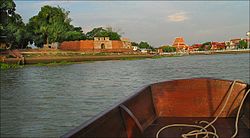
Ayutthaya's military was the origin of the Royal Thai Army. The army was organized into a small standing army of a few thousand, which defended the capital and the palace, and a much larger conscript-based wartime army. Conscription was based on the Phrai system (including phrai luang and phrai som), which required local chiefs to supply their predetermined quota of men from their jurisdiction on the basis of population in times of war. This basic system of military organization was largely unchanged down to the early Rattanakosin period.
The main weaponry of the infantry largely consisted of swords, spears and bow and arrows. The infantry units were supported by cavalry and elephantry corps.
Territory
According to a French source, Ayutthaya in the 18th century included these principal cities: Martaban, Ligor or Nakhon Sri Thammarat, Tenasserim, Junk Ceylon or Phuket Island, Singora or Songkhla. Her tributaries were Patani, Pahang, Perak, Kedah and Malacca.[114]
Particularly in the South, Ayutthaya's claims were often discredited or underplayed by the Malay sultanates, resulting in some number of military expeditions starting in the 17th and 18th centuries to subjugate querulous sultanates, most infamously with King Narai's military expedition to the Sultanate of Singora in 1680.
Culture and society
Population
For the entirety of the Ayutthaya Kingdom's duration, it was largely managed by a society of a service nobility composed of a few thousand and serfs (phrai) composed of the rest of the population, comparable to the contemporary Ancien Regime in France or Feudalism in the rest of Europe.[115] The social ladder existed during times of war and, particularly during the late Ayutthaya period, of rich commoners challenging the societal status quo of the Ayutthaya Kingdom as a result of commercial prosperity during the kingdom's last 150 years of peaceful existence.
According to the historian Chris Baker, the Ayutthaya peasantry practiced commuter agriculturalism and largely lived in dense areas along the canals leading up to the city of Ayutthaya and other cities within the kingdom, producing homemade goods and textiles for the international market.
Language
The Siamese (Thai) language was initially spoken only by the Ayutthaya elite, but gradually grew to transcend social classes and becoming widespread throughout the kingdom by the Late Ayutthaya period (1688-1767),[116] although the Mon language was spoken among everyday people throughout the Chao Phraya delta until as late as c. 1515.[117] The Khmer language was an early prestige language of the Ayutthaya court, until it was supplanted by the Siamese language,[118] however it was still continually spoken by the ethnic Khmer community living in Ayutthaya. Many variants of Chinese were spoken, with the Chinese becoming a large minority in the kingdom during the Late Ayutthaya period.[119]
Various minority languages spoken inside the kingdom included Malay, Persian, Japanese, Cham, Dutch, Portuguese, etc...
Religion
Ayutthaya's main religion was Theravada Buddhism. However, many of the elements of the political and social system were incorporated from Hindu scriptures and were conducted by Brahmin priests.[110] Many areas of the kingdom also practiced Mahayana Buddhism, Islam[120] and, influenced by French Missionaries who arrived through China in the 17th century, some small areas converted to Roman Catholicism.[121] The influence of Mahayana and Tantric practices also entered Theravada Buddhism, producing a tradition called Tantric Theravada.
The natural world was also home to a number of spirits which are part of the Satsana Phi. Phi (Thai: ผี) are spirits of buildings or territories, natural places, or phenomena; they are also ancestral spirits that protect people, or can also include malevolent spirits. The phi which are guardian deities of places, or towns are celebrated at festivals with communal gatherings and offerings of food. The spirits run throughout Thai folklore.[122]
Phi were believed to influence natural phenomena including human illness and thus the baci became an important part of people identity and religious health over the millennia. Spirit houses were an important folk custom which were used to ensure balance with the natural and supernatural world. Astrology was also a vital part to understanding the natural and spiritual worlds and became an important cultural means to enforce social taboos and customs.
Arts and performances
The myth and epic stories of Ramakien provide the Siamese with a rich source of dramatic materials. The royal court of Ayutthaya developed classical dramatic forms of expression called khon (Thai: โขน) and lakhon (Thai: ละคร). Ramakien played a role in shaping these dramatic arts. During the Ayutthaya period, khon, or a dramatized version of Ramakien, was classified as lakhon nai or a theatrical performance reserved only for aristocratic audience. The Siamese drama and classical dance later spread throughout mainland Southeast Asia and influenced the development of high-culture art in most countries, including Burma, Cambodia, and Laos.[123]
Historical evidence shows that the Thai art of stage plays must have already been highly evolved by the 17th century. Louis XIV, the Sun King of France, had a formal diplomatic relation with Ayutthaya's King Narai. In 1687, France sent the diplomat Simon de la Loubère to record all that he saw in the Siamese Kingdom. In his famous account Du Royaume de Siam, La Loubère carefully observed the classic 17th century theatre of Siam, including an epic battle scene from a khon performance, and recorded what he saw in great detail:
The Siamese have three sorts of Stage Plays: That which they call Cone [khôn] is a figure dance, to the sound of the violin and some other instruments. The dancers are masked and armed, and represent rather a combat than a dance. And though every one runs into high motions, and extravagant postures, they cease not continually to intermix some word. Most of their masks are hideous, and represent either monstrous Beasts, or kinds of Devils. The Show which they call Lacone is a poem intermix with Epic and Dramatic, which lasts three days, from eight in the morning till seven at night. They are histories in verse, serious, and sung by several actors always present, and which do only sing reciprocally .... The Rabam is a double dance of men and women, which is not martial, but gallant ... they can perform it without much tying themselves, because their way of dancing is a simple march round, very slow, and without any high motion; but with a great many slow contortions of the body and arms.[124]
Of the attire of Siamese Khôn dancers, La Loubère recorded that, "[T]hose that dance in Rabam, and Cone, have gilded paper-bonnets, high and pointed, like the Mandarins caps of ceremony, but which hang down at the sides below their ears, which are adorned with counterfeit stones, and with two pendants of gilded wood."[124]
La Loubère also observed the existence of muay Thai and muay Laos, noting that they looked similar (i.e., using both fists and elbows to fight) but the hand-wrapping techniques were different.[124] Muay Thai from the Ayuthtaya period (better known as Muay Boran) would greatly influence the modern sport of Muay Thai.
The accomplishment and influence of Thai art and culture, developed during the Ayutthaya period, on the neighboring countries was evident in the observation of James Low, a British scholar on Southeast Asia, during the early-Rattanakosin Era: "The Siamese have attained to a considerable degree of perfection in dramatic exhibitions – and are in this respect envied by their neighbours the Burmans, Laos, and Cambojans who all employ Siamese actors when they can be got."[123]:177
Krabi-krabong is a form of swordfighting developed in Ayutthaya that is now recognized as an essential element of traditional Thai culture and arts.[125] Wat Phutthaisawan, a major ancient temple in Ayutthaya, is considered to be the birthplace of krabi-krabong.
Literature
Ayutthaya was a kingdom rich in literary production. Even after the sack of Ayutthaya in 1767, many literary masterpieces in the Thai language survived. However, Ayutthayan literature (as well as Thai literature before the modern era) was dominated by verse composition (i.e., poetry), whereas prose works were reserved to legal matters, records of state affairs and historical chronicles. Thus, there are many works in the nature of epic poetry in the Thai language. The Thai poetical tradition was originally based on indigenous poetical forms such as rai (ร่าย), khlong (โคลง), kap (กาพย์) and klon (กลอน). Some of these poetical forms—notably khlong—have been shared between the speakers of tai languages since ancient time (before the emergence of Siam).
Sanskrit influence on the Siamese language
Through Buddhist and Hindu influence, a variety of Chanda prosodic meters were received via Ceylon. Since the Thai language is mono-syllabic, a huge number of loan words from Sanskrit and Pali are needed to compose these classical Sanskrit meters. According to B.J. Terwiel, this process occurred with an accelerated pace during the reign of King Borommatrailokkanat (1448–1488) who reformed Siam's model of governance by turning the Siamese polity into an empire under the mandala feudal system.[126]:307–326 The new system demanded a new imperial language for the noble class. This literary influence changed the course of the Thai or Siamese language, setting it apart from other tai languages, by increasing the number of Sanskrit and Pali words drastically and imposing the demand on the Thais to develop a writing system that preserves the orthography of Sanskrit words for literary purpose. By the 15th century, the Thai language had evolved into a distinctive medium along with a nascent literary identity of a new nation. It allowed Siamese poets to compose in different poetical styles and mood, from playful and humorous rimed verses, to romantic and elegant klong and to polished and imperious chan prosodies modified from classical Sanskrit meters. Thai poets experimented with these different prosodic forms, producing innovative "hybrid" poems such as Lilit (Thai: ลิลิต, an interleave of khlong and kap or rai verses) or Kap hor Klong (Thai: กาพย์ห่อโคลง - khlong poems enveloped by kap verses). The Thai thus developed a keen mind and a keen ear for poetry. To maximize this new literary medium, however, an intensive classical education in Pali was required. This made poetry an exclusive occupation of the noble classes. However, B.J. Terwiel notes, citing a 17th-century text book Jindamanee, that scribes and common Siamese men, too, were encouraged to learn basic Pali and Sanskrit for career advancement.[126]:322–323
Ramakien
Most countries in Southeast Asia share an Indianised culture. Traditionally, therefore, Thai literature was heavily influenced by the Indian culture and Buddhist-Hindu ideology since the time it first appeared in the 13th century. Thailand's national epic is a version of the story of Rama-Pandita, as recounted by Gotama Buddha in the Dasharatha Jataka called the Ramakien,[127] translated from Pali and rearranged into Siamese verses. The importance of the Ramayana epic in Thailand is due to the Thai's adoption of the Hindu religio-political ideology of kingship, as embodied by Rama. The Siamese capital, Ayutthaya, was named after the holy city of Ayodhya, the city of Rama. Thai kings of the current dynasty from Rama VI forward, and retroactively, have been referred to as "Rama" to the present day (relations with the west caused the crown to seek a brief name to convey royalty to both Thais and foreigners, following European styles).
A number of versions of the Ramakien epic were lost in the destruction of Ayutthaya in 1767. Three versions currently exist. One of these was prepared under the supervision (and partly written by) King Rama I. His son, Rama II, rewrote some parts for khon drama. The main differences from the original are an extended role for the monkey god Hanuman and the addition of a happy ending. Many of popular poems among the Thai nobles are also based on Indian stories. One of the most famous is Anirut Kham Chan which is based on an ancient Indian story of Prince Anirudha.
Khun Chang Khun Phaen: the Siamese epic folk poem
In the Ayutthaya period, folktales also flourished. One of the most famous folktales is the story of Khun Chang Khun Phaen (Thai: ขุนช้างขุนแผน), referred to in Thailand simply as "Khun Phaen", which combines the elements of romantic comedy and heroic adventures, ending in high tragedy. The epic of Khun Chang Khun Phaen (KCKP) revolves around Khun Phaen, a Siamese general with superhuman magical powers who served the King of Ayutthaya, and his love-triangle relationship between himself, Khun Chang, and a beautiful Siamese girl named Wan-Thong. The composition of KCKP, much like other orally-transmitted epics, evolved over time. It originated as a recitation or sepha within the Thai oral tradition from around the beginning of the 17th century (c. 1600). Siamese troubadours and minstrels added more subplots and embellished scenes to the original story line as time went on.[128] By the late period of the Ayutthaya Kingdom, it had attained the current shape as a long work of epic poem with the length of about 20,000 lines, spanning 43 samut thai books. The version that exists today was composed with klon meter throughout and is referred to in Thailand as nithan Kham Klon (Thai: นิทานคำกลอน) meaning a 'poetic tale'.
Architecture
The Ayutthaya Buddhist temple falls into one of two broad categories: the stupa-style solid temple and the prang-style (Thai: ปรางค์). The prangs can also be found in various forms in Sukhothai, Lopburi, Bangkok (Wat Arun). Sizes may vary, but usually the prangs measure between 15 and 40 meters in height, and resemble a towering corn-cob like structure.
Prangs essentially represent Mount Meru. In Thailand Buddha relics were often housed in a vault in these structures, reflecting the belief that the Buddha is a most significant being, having attained enlightenment and having shown the path to enlightenment to others.[129]
Notable archeological sites
| Name | Picture | Built | Sponsor(s) | Notes |
|---|---|---|---|---|
| Chan Palace, Phitsanulok | 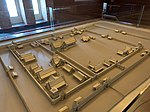
|
Built during the Sukhothai period (1238–1438) | King Maha Thammaracha I of Sukhothai | Former royal residence of the Front Palaces of Ayutthaya: King Trailokanat, and King Naresuan. Used as a royal residence from the Sukhothai period until it was abandoned by Naresuan. |
| Chedi Phukhao Thong | 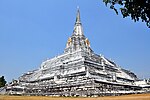
|
1587 (rebuilt in 1744)[130] | Prince (later King) Naresuan King Borommakot[130] |
Built to commemorate a battle victory following Ayutthaya's liberation from Burma in 1584[130] |
| Elephant Kraal Pavilion (พระที่นั่งเพนียด) | 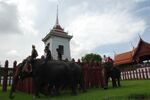
|
16th century[131] | Royal elephant kraal formerly used by Ayutthaya monarchs, one of the few still existing in Thailand. Used as an elephant camp today. | |
| Front Palace, Ayutthaya | 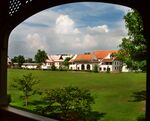
|
Main residence of the Front Palaces of Ayutthaya. Restored by King Mongkut. Currently houses the Chan Kasem National Museum.[132] | ||
| King Narai's Palace, Lopburi | 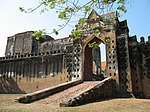
|
1666 | King Narai | Palace of King Narai from 1666 until his death in 1688 |
| Prasat Nakhon Luang | 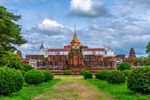
|
1631[133][134] | King Prasat Thong | Mostly reconstructed during the reign of King Rama V. |
| Wat Chai Watthanaram | 
|
1630 | King Prasat Thong | |
| Wat Ko Kaew Suttharam, Phetchaburi | 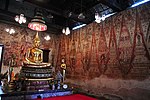
|
1734[135] | King Borommakot[135] | One of the best examples of 18th-century Ayutthaya temple (wat) murals |
| Wat Kudi Dao | 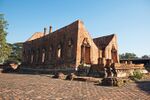
|
Before 1711[136] | Prince, later King Borommakot[136] | A good example of 18th-century Late Ayutthaya architecture. Partially restored.[136] |
| Wat Mahathat | 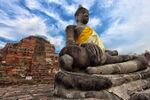
|
1374 | King Borommarachathirat I | |
| Wat Na Phra Men | 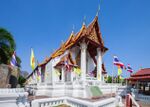
|
1503[137] | King Ramathibodi II | One of the best preserved Ayutthaya temples. Survived the Fall of Ayutthaya in 1767. Restored during the reign of Rama III (r. 1824-51).[137] |
| Wat Phanan Choeng | 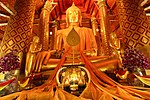
|
1324 | Built 27 years before the founding of Ayutthaya. Revered temple still in use. | |
| Wat Phra Ram | 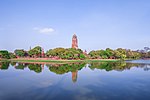
|
1369 | King Ramesuan | |
| Wat Phra Phutthabat (วัดพระพุทธบาท), Saraburi |

|
1624[138] | King Songtham | Pilgrimage site in Thailand up to the present. |
| Wat Phra Si Sanphet | 
|
1351 | King Ramathibodi I | |
| Wat Phutthaisawan | 
|
Before 1351 | King Ramathibodi I | Built before Ayutthaya was founded; birthplace of Thai krabi-krabong sword fighting |
| Wat Ratchaburana | 
|
1424 | King Borommarachathirat II | |
| Wat Thammikarat | 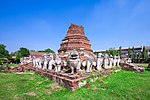
|
Before 1351 | ||
| Wat Yai Chai Mongkhon | 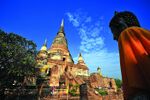
|
1357[139] | King Ramathibodi I[139] | |
| Wihan Phra Mongkhon Bophit | 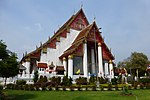
|
Heavily renovated during the reign of King Borommakot (r. 1733–1758) | King Borommakot | Heavily damaged by the Burmese sack in 1767, the wihan's current appearance is largely from King Borommakot's major renovations of the temple in the 18th century. Largely reconstructed in the mid-20th century.[140] |
Daily life
Clothing
Three clothing styles were evident in the Ayutthaya period. Each style depended on social class.
1. Court clothing (worn by the king, queen, concubines, and senior government officials):
- Men: The king wore mongkut (Thai: มงกุฎ), as headgear, round Mandarin collar with khrui and wore chong kben (Thai: โจงกระเบน), as trousers.
- Court officers, (who served in the royal palace) wore lomphok, as headgear, khrui, and wore chong kben.
- Women The queen wore chada (Thai: ชฎา), as headgear, sabai (Thai: สไบ), (a breast cloth that wrap over one shoulder around chest and back) and wore pha nung (Thai: ผ้านุ่ง), as a skirt.
- Concubines wore long hair, sabai, and pha nung.
2. Nobles (rich citizens):
- Men: wore mandarin collar shirt, a mahadthai hair style (Thai: ทรงมหาดไทย), and wore chong kben.
- Women: wore the sabai and pha nung.
3. Villagers:
- Men: wore a loincloth, displayed a naked chest, a mahadthai hair style, sometimes wore sarong or chong kben.
- Women: wore the sabai and pha nung.
Economy
- The Thais never lacked a rich food supply. Peasants planted rice for their own consumption and to pay taxes. Whatever remained was used to support religious institutions. From the 13th to the 15th centuries, however, a transformation took place in Thai rice cultivation. In the highlands, where rainfall had to be supplemented by a system of irrigation[141] to control water levels in flooded paddies, the Thais sowed the glutinous rice that is still the staple in the geographical regions of the north and northeast. But in the floodplain of the Chao Phraya, farmers turned to a different variety of rice—the so-called floating rice, a slender, non-glutinous grain introduced from Bengal—that would grow fast enough to keep pace with the rise of the water level in the lowland fields.[142]
The new strain grew easily and abundantly, producing a surplus that could be sold cheaply abroad. Ayutthaya, at the southern extremity of the floodplain, thus became the hub of economic activity. Under royal patronage, corvée labour dug canals on which rice was brought from the fields to the king's ships for export to China. In the process, the Chao Phraya delta—mud flats between the sea and firm land hitherto considered unsuitable for habitation—was reclaimed and cultivated. Traditionally the king had a duty to perform a religious ceremony to bless the rice planting.[142]
Although rice was abundant in Ayutthaya, rice exports were banned from time to time when famine occurred because of natural calamity or war. Rice was usually bartered for luxury goods and armaments from Westerners, but rice cultivation was mainly for the domestic market and rice export was evidently unreliable.
Trade

Currency
Ayutthaya officially used cowrie shells, prakab (baked clay coins), and pod duang as currencies. Pod duang became the standard medium of exchange from the early-13th century to the reign of King Chulalongkorn.
Ayutthaya as international trading port
Trade with Europeans was lively in the 17th century. In fact European merchants traded their goods, mainly modern arms such as rifles and cannons, for local products from the inland jungle such as sappan (lit. 'bridge')[citation needed] woods, deerskin, and rice. Tomé Pires, a Portuguese voyager, mentioned in the 16th century that Ayutthaya, or Odia, was "rich in good merchandise". Most of the foreign merchants coming to Ayutthaya were European and Chinese, and were taxed by the authorities. The kingdom had an abundance of rice, salt, dried fish, arrack, and vegetables.[143]
Trade with foreigners, mainly the Dutch, reached its peak in the 17th century. Ayutthaya became a main destination for merchants from China and Japan. It was apparent that foreigners began taking part in the kingdom's politics. Ayutthaya's kings employed foreign mercenaries who sometimes joined the wars with the kingdom's enemies. However, after the purge of the French in the late-17th century, the major traders with Ayutthaya were the Chinese. The Dutch from the Dutch East Indies Company (Vereenigde Oost-Indische Compagnie or VOC), were still active. Ayutthaya's economy declined rapidly in the 18th century, until the Burmese invasion caused the total collapse of Ayutthaya's economy in 1767.[144]
Contacts with the West

Light Green - territories conquered or ceded
Dark Green (Allied) - Ayutthaya
Yellow - Main Factories
In 1511, immediately after having conquered Malacca, the Portuguese sent a diplomatic mission headed by Duarte Fernandes to the court of King Ramathibodi II of Ayutthaya. Having established amicable relations between the Kingdom of Portugal and the Kingdom of Siam, they returned with a Siamese envoy who carried gifts and letters to the King of Portugal.[145] The Portuguese were the first Europeans to visit the country. Portuguese mercenaries would also play a major role in the invasion of Lanna in 1539 by King Chairachathirat, and Portuguese soldiers would be considered a respected fighting force for the Kingdom across its existence.[55]:37 Five years after that initial contact, Ayutthaya and Portugal concluded a treaty granting the Portuguese permission to trade in the kingdom. A similar treaty in 1592 gave the Dutch a privileged position in the rice trade.
Foreigners were cordially welcomed at the court of Narai (1657–1688), a ruler with a cosmopolitan outlook who was nonetheless wary of outside influence. Important commercial ties were forged with Japan. Dutch and English trading companies were allowed to establish factories, and Thai diplomatic missions were sent to Paris and The Hague. By maintaining these ties, the Thai court skillfully played off the Dutch against the English and the French, avoiding the excessive influence of a single power.[146]
In 1664, however, the Dutch used force to exact a treaty granting them extraterritorial rights as well as freer access to trade. At the urging of his foreign minister, the Greek adventurer Constantine Phaulkon, Narai turned to France for assistance. French engineers constructed fortifications for the Thais and built a new palace at Lopburi for Narai. In addition, French missionaries engaged in education and medicine and brought the first printing press into the country. Louis XIV's personal interest was aroused by reports from missionaries suggesting that Narai might be converted to Christianity.[147]
The French presence encouraged by Phaulkon, however, stirred the resentment and suspicions of the Thai nobles and Buddhist clergy. When word spread that Narai was dying, a general, Phetracha (reigned 1688–1693) staged a coup d'état, the 1688 Siamese revolution, seized the throne, killed the designated heir, a Christian, and had Phaulkon put to death along with a number of missionaries. He then expelled the remaining foreigners. Some studies said that Ayutthaya began a period of alienation from European traders, while welcoming more Chinese merchants. But other recent studies argue that, due to wars and conflicts in Europe in the mid-18th century, European merchants reduced their activities in the East. However, it was apparent that the Dutch East Indies Company or VOC was still doing business in Ayutthaya despite political difficulties.[147]
French Jesuits observing an eclipse with King Narai and his court in April 1688, shortly before the Siamese revolution.
A portrait of Kosa Pan, a Thai ambassador accredited by King Narai of Ayutthaya to the court of King Louis XIV of France, by Charles Le Brun, 1686
Contacts with East Asia
Between 1405 and 1433, the Chinese Ming dynasty sponsored a series of seven naval expeditions. Emperor Yongle designed them to establish a Chinese presence, impose imperial control over trade, and impress foreign peoples in the Indian Ocean basin. He also might have wanted to extend the tributary system. It is believed that the Chinese fleet under Admiral Zheng He travelled up the Chao Phraya River to Ayutthaya on three occasions.
Meanwhile, a Japanese colony was established in Ayutthaya. The colony was active in trade, particularly in the export of deer hides and saphan wood to Japan in exchange for Japanese silver and Japanese handicrafts (swords, lacquered boxes, high-quality paper). From Ayutthaya, Japan was interested in purchasing Chinese silks, as well as deerskins and ray or shark skins (used to make a sort of shagreen for Japanese sword handles and scabbards).[148]
The Japanese quarters of Ayutthaya were home to about 1,500 Japanese inhabitants (some estimates run as high as 7,000). The community was called Ban Yipun in Thai, and was headed by a Japanese chief nominated by Thai authorities.[149] It seems to have been a combination of traders, Christian converts (Kirishitan) who had fled their home country to various Southeast Asian countries following the persecutions of Toyotomi Hideyoshi and Tokugawa Ieyasu, and unemployed former samurai who had been on the losing side at the battle of Sekigahara.[149]
Padre António Francisco Cardim recounted having administered the sacrament to around 400 Japanese Christians in 1627 in the Thai capital of Ayuthaya ("a 400 japoes christaos")[149] There were also Japanese communities in Ligor and Patani.[150]
Notable foreigners in 17th century Ayutthaya
- Constantine Phaulkon, Greek adventurer and first councillor of King Narai
- François-Timoléon de Choisy
- Father Guy Tachard, French Jesuit writer and Siamese Ambassador to France (1688)
- Louis Laneau, Apostolic Vicar of Siam
- Claude de Forbin, French Admiral
- Yamada Nagamasa, Japanese adventurer who became the ruler of the Nakhon Si Thammarat
- George White (merchant), English merchant
- Jeremias van Vliet, Dutch Opperhoofd
Historiography
Contemporary accounts of Ayutthaya
The amount to which Ayutthaya texts were destroyed in the Burmese sack of 1767 varies greatly. Van Vliet's written records on Siam is the earliest written history of Siam and Ayutthaya, which date from the early to mid 17th century and likely used the religious temple chronicles as his source. The earliest surviving palace chronicle is the Luang Prasoet chronicle, which dates from 1681. The histories of Ayutthaya was not regarded as important until the age of commerce and peace in the 17th and 18th centuries. Early Ayutthaya did not write down its history. The religious chronicles are also important to understanding Ayutthaya, which date as early as the 16th century. Early Ayutthaya did not write down its history. A significant portion of written evidence must therefore come from outside accounts. Aside from Van Vliet, a number of Europeans in the 17th and early 18th century wrote surviving accounts of Siam. The Chinese palace chronicles are also instrumental in analyzing Ayutthaya's history.[56]
The Ayutthaya Testimonies are another important account of the Ayutthaya Kingdom. Based on the testimonies of the former inhabitants of the Ayutthaya Kingdom and survived by three different documents, these accounts attests to the description of the city of Ayutthaya and the Ayutthaya Kingdom prior to and during its fall in 1767.
Post-Ayutthaya historiography
The history of the Ayutthaya Kingdom overall has been a neglected period of historiography in Thailand, as well as abroad, characterized by well-researched and popular histories of subperiods of Ayutthaya. Chris Baker and Pasuk Phongpaichit's "A History of Ayutthaya: Siam In the Early Modern World", published in 2017, was the first English-academic book to have analyzed the full four hundred years of the Ayutthaya Kingdom's existence. The historiography of Southeast Asia originated from post-colonial capitals. As Thailand had never been fully colonized, it never had a European patron from which national histories could be written about themselves until the arrival of the Americans in the 1960s.[151][56]
In the early Rattanakosin period, King Rama I compiled all surviving Ayutthaya law records and published the Three Seals Law in 1805. Early Rattanakosin period documents traced their "national" origins to the founding of Ayutthaya in 1351. In the early 20th-century however, Thai elites, influenced by Western ideas of European nationalism and the nation state, used that framework to create a nationalist history of Thailand, implementing it in ways deemphasized Ayutthaya's importance to Thai history by portraying the Sukhothai Kingdom as the first "Thai" kingdom or golden age of "Thai-ness" (Buddhism, Thai-style democracy, free trade, abolition of slavery), Rattanakosin as the "rebirth", and Ayutthaya as a period of decline between Sukhothai and Rattanakosin. This resulted in Ayutthaya being largely forgotten in the historiography of Thailand for half a century following the works of Prince Damrong in the early 20th century.[152][153]
The nationalist-themed histories of Ayutthaya, pioneered by Prince Damrong, primarily featured the stories of kings fighting wars and the idea of territorial subjugation of neighboring states. These historical themes remains influential in Thailand and in Thai popular history up until the present, which has only been challenged by a newer generation of historians and academics in Thailand and abroad starting in the 1980s, emphasizing the long-neglected commercial and economic aspects which were important to Ayutthaya. New released sources and translations from a variety of historical records (China, the Netherlands, etc...) have made the researching of Ayutthaya history more accessible in the past two and three decades.[56][154]
Since the 1970s, newer generations of academics have come up and challenged the old historiography, paying more attention and publishing works about the history of Ayutthaya, prominently beginning with Charnvit Kasetsiri's "The Rise of Ayudhya", published in 1977.[155][156][157][158] Kasetsiri, in 1999, argues that, "Ayutthaya was the first major political, cultural, and commercial center of the Thai."[159][160]
The "General Crisis" hypothesis
The idea that Ayutthaya suffered a decline following the departure of Europeans in the late 17th century was an idea popularized, at first, in the Rattanakosin court, in an attempt to legitimize the new dynasty over the Ayutthaya Ban Phlu Luang dynasty, and more famously by Anthony Reid's book on the "Age of Commerce" in recent decades. However, more recent studies, such as by Victor Lieberman in "Strange Parallels in Southeast Asia" and by Baker and Phongpaichit in "A History of Ayutthaya", have mostly refuted Reid's hypothesis, in particular Lieberman criticizing Reid's methodology of using the example of Maritime Southeast Asia to explain Mainland Southeast Asia, citing the opening of Qing China's revocation of its maritime ban and the subsequent increase in trade between China and Siam and Ayutthaya's historical importance as a regional Asian trade center rather than one in which Europeans held any power or any significant influence for any extended period of time.[90][156][161][162]
Gallery
In popular culture
- Love Destiny (TV series) (Thai: บุพเพสันนิวาส; Bupphesanniwat), 2018 Thai historical television series.
- The Legend of Suriyothai, 2001 Thai biographical historical drama film series about Queen Suriyothai.
- King Naresuan (film), 2007–2015 Thai biographical historical drama film series about King Naresuan.
See also
- Ayutthaya Historical Park
- Ayutthaya Province
- Baan Hollanda
- Bang Rajan
- Family tree of Ayutthaya kings
- History of Thailand
- List of Ayutthaya kings
Notes
- ↑ Before Ayutthaya's official foundation date. Ayutthaya was first referred to as "Xian" in Chinese records.
- ↑ Used by Thai historians to refer to Sukhothai and Phitsanulok (Thai: Mueang Nua).
- ↑ Roberts, Edmund (1837). "XVIII City of Bang-kok". Embassy to the Eastern courts of Cochin-China, Siam, and Muscat in the U. S. sloop-of-war Peacock during the years 1832-3-4. Harper & Brothers. p. image 288. OCLC 12212199. https://archive.org/details/embassytoeaster00unkngoog. "The spot on which the present capital stands, and the country in its vicinity, on both banks of the river for a considerable distance, were formerly, before the removal of the court to its present situation called Bang-kok; but since that time, and for nearly sixty years past, it has been named Sia yuthia, (pronounced See-ah you-tè-ah, and by the natives, Krung, that is, the capital;) it is called by both names here, but never Bang-kok; and they always correct foreigners when the latter make this mistake. The villages which occupy the right hand of the river, opposite to the capital, pass under the general name of Bang-kok."
Citations
- ↑ 1.0 1.1 1.2 1.3 Baker, Chris; Phongpaichit, Pasuk (2017). A History of Ayutthaya: Siam in the Early Modern World. Cambridge University Press. ISBN 978-1-316-64113-2. https://books.google.com/books?id=GHiuDgAAQBAJ.
- ↑ 2.0 2.1 2.2 2.3 2.4 2.5 2.6 2.7 2.8 2.9 Baker, Chris; Phongpaichit, Pasuk (2017). A History of Ayutthaya: Siam in the Early Modern World. Cambridge University Press. ISBN 978-1-107-19076-4. https://www.cambridge.org/core/books/history-of-ayutthaya/52FC0674CC0532A8F1EDB01CC37E703B.
- ↑ Baker, Chris; Phongpaichit, Pasuk (2017). A History of Ayutthaya: Siam in the Early Modern World. Cambridge University Press. p. 64. ISBN 978-1-316-64113-2. https://books.google.com/books?id=GHiuDgAAQBAJ.
- ↑ Wood 1924, pp. 241–242.
- ↑ Baker, Chris; Phongpaichit, Pasuk (2017). A History of Ayutthaya: Siam in the Early Modern World. Cambridge University Press. pp. 46, 51. ISBN 978-1-316-64113-2. https://books.google.com/books?id=GHiuDgAAQBAJ.
- ↑ Baker, Chris; Phongpaichit, Pasuk (2017). A History of Ayutthaya: Siam in the Early Modern World. Cambridge University Press. pp. 50. ISBN 978-1-316-64113-2. https://books.google.com/books?id=GHiuDgAAQBAJ.
- ↑ Lieberman, Victor (2003). Strange Parallels: Volume 1, Integration on the Mainland: Southeast Asia in Global Context, c.800–1830 (Studies in Comparative World History) (Kindle ed.). Cambridge University Press. p. 295. ISBN 978-0521800860. "Siam's population must have increased from c. 2,500,000 in 1600 to 4,000,000 in 1800."
- ↑ 8.0 8.1 Baker, Chris (2003). "Ayutthaya Rising: From Land or Sea?". Journal of Southeast Asian Studies 34 (1): 41–62. doi:10.1017/S0022463403000031. ISSN 0022-4634. https://www.jstor.org/stable/20072474.
- ↑ Wyatt 2003, p. 86.
- ↑ "AYUTTHAYA | National Virtual Museum" (in en-US). https://thai-heritage.org/ayutthaya/.
- ↑ (in en) The Siam Society Lecture: A History of Ayutthaya (28 June 2017), https://www.youtube.com/watch?v=2xA5I0jxoV8, retrieved 2023-10-29
- ↑ 12.00 12.01 12.02 12.03 12.04 12.05 12.06 12.07 12.08 12.09 12.10 12.11 12.12 12.13 12.14 12.15 Baker, Chris; Phongpaichit, Pasuk (2017). A History of Ayutthaya: Siam in the Early Modern World. Cambridge University Press. ISBN 978-1-107-19076-4. https://www.cambridge.org/core/books/history-of-ayutthaya/52FC0674CC0532A8F1EDB01CC37E703B.
- ↑ Wyatt 2003, pp. 109–110.
- ↑ 14.0 14.1 Baker, Chris; Phongpaichit, Pasuk (2017). A History of Ayutthaya: Siam in the Early Modern World (Kindle ed.). Cambridge University Press. ISBN 978-1-316-64113-2. https://books.google.com/books?id=GHiuDgAAQBAJ.
- ↑ Lieberman, Victor (2003). Strange Parallels: Volume 1, Integration on the Mainland: Southeast Asia in Global Context, c.800–1830 (Studies in Comparative World History) (Kindle ed.). Cambridge University Press. p. 290. ISBN 978-0521800860. "From the early 1700s well into the 19th century Chinese not only dominated Siam's external trade..."
- ↑ 16.0 16.1 16.2 Lieberman, Victor B.; Victor, Lieberman (14 May 2014) (in en). Strange Parallels: Southeast Asia in Global Context, C 800-1830. Cambridge University Press. ISBN 978-0-511-65854-9. https://books.google.com/books?id=vQl2AQAACAAJ.
- ↑ Boeles, J.J. (1964). "The King of Sri Dvaravati and His Regalia". Journal of the Siam Society 52 (1): 102–103. https://thesiamsociety.org/wp-content/uploads/1964/03/JSS_052_1f_Boeles_KingOfDvaravatiAndRegalia.pdf. Retrieved 13 April 2023.
- ↑ Pongsripian, Winai (1983). Traditional Thai historiography and its nineteenth century decline (PDF) (PhD). University of Bristol. p. 21. Retrieved 13 April 2023.
- ↑ Blagden, C.O. (1941). "A XVIIth Century Malay Cannon in London". Journal of the Malayan Branch of the Royal Asiatic Society 19 (1): 122–124. https://www.jstor.org/stable/41559979. Retrieved 13 April 2023. "TA-HTAUNG TA_YA HNIT-HSE SHIT-KHU DWARAWATI THEIN YA - 1128 year (= 1766 A.D) obtained at the conquest of Dwarawati (= Siam). One may note that in that year the Burmese invaded Siam and captured Ayutthaya, the capital, in 1767.".
- ↑ JARUDHIRANART, Jaroonsak (2017). THE INTERPRETATION OF SI SATCHANALAI (Thesis). Silpakorn University. p. 31. Retrieved 13 April 2023.
Ayutthaya, they still named the kingdom after its former kingdom as "Krung Thep Dvaravati Sri Ayutthaya".
- ↑ 21.0 21.1 21.2 "AYUTTHAYA | National Virtual Museum" (in en-US). https://thai-heritage.org/ayutthaya/.
- ↑ 22.0 22.1 Smith, R. B. (February 1978). "Charnvit Kasetsiri: The rise of Ayudhya: a history of Siam in the fourteenth and fifteenth centuries. (East Asian Historical Monographs.) xii, 194 pp. Kuala Lumpur, etc.: Oxford University Press, 1976. £14.25." (in en). Bulletin of the School of Oriental and African Studies 41: 202–203. doi:10.1017/S0041977X00058286. https://www.cambridge.org/core/journals/bulletin-of-the-school-of-oriental-and-african-studies/article/abs/charnvit-kasetsiri-the-rise-of-ayudhya-a-history-of-siam-in-the-fourteenth-and-fifteenth-centuries-east-asian-historical-monographs-xii-194-pp-kuala-lumpur-etc-oxford-university-press-1976-1425/159F505F141EF6AE6E7A0222D188A96A.
- ↑ Lieberman, Victor B.; Victor, Lieberman (14 May 2014) (in en). Strange Parallels: Southeast Asia in Global Context, C 800-1830. Cambridge University Press. ISBN 978-0-511-65854-9. https://books.google.com/books?id=vQl2AQAACAAJ.
- ↑ Baker, Chris; Phongpaichit, Pasuk (11 May 2017) (in English). A History of Ayutthaya: Siam in the Early Modern World (Kindle ed.). Cambridge University Press. pp. 44–46. https://www.amazon.com/History-Ayutthaya-Early-Modern-World-ebook/dp/B071KX8HY5/ref=tmm_kin_swatch_0?_encoding=UTF8&qid=&sr=.
- ↑ Baker, Chris; Phongpaichit, Pasuk (2017) (in en). A History of Ayutthaya. Cambridge University Press. pp. 43. ISBN 978-1-107-19076-4. https://books.google.com/books?id=GHiuDgAAQBAJ.
- ↑ 26.0 26.1 Kasetsiri, Charnvit. "REVIEW ARTICLE: A NEW TAMNAN ABOUT AYUDHYA – The Rise of Ayudhya: A History of Siam in the Fourteenth and Fifteenth Centuries". https://thesiamsociety.org/wp-content/uploads/1979/03/JSS_067_2k_Vickery_ReviewArticleNewTamnanAboutAyutthaya.pdf.
- ↑ "รายการ "อดีตในอนาคต" ตอนที่ ๑๗ สุพรรณภูมิ". http://lek-prapai.org/home/view.php?id=5382.
- ↑ Thepthani 1953, p. 95.
- ↑ Thepthani 1953, p. 96-97.
- ↑ Thepthani 1953, p. 97.
- ↑ Thepthani 1953, p. 98.
- ↑ 32.0 32.1 Thepthani 1953, p. 99.
- ↑ "3,000ปี ลพบุรีไม่เคยร้าง "ขรรค์ชัย-สุจิตต์" ชวนทอดน่องเมืองละโว้ ค้นต้นกำเนิดอยุธยา" (in th). Matichon. 18 December 2017. Archived from the original on 26 October 2023. https://archive.today/20231026145922/https://www.matichon.co.th/news-monitor/news_771434. Retrieved 26 October 2023.
- ↑ 34.0 34.1 Thepthani 1953, p. 101.
- ↑ Thepthani 1953, p. 102.
- ↑ Thepthani 1953, p. 103.
- ↑ 37.0 37.1 Thepthani 1953, p. 104.
- ↑ Thepthani 1953, p. 109.
- ↑ 39.0 39.1 Thepthani 1953, p. 110.
- ↑ Baker, Chris; Phongpaichit, Pasuk (11 May 2017) (in English). A History of Ayutthaya: Siam in the Early Modern World (Kindle ed.). Cambridge University Press. p. 43. https://www.amazon.com/History-Ayutthaya-Early-Modern-World-ebook/dp/B071KX8HY5/ref=tmm_kin_swatch_0?_encoding=UTF8&qid=&sr=.
- ↑ "The Siam Society Lecture: A History of Ayutthaya (28 June 2017)" (in en). https://www.youtube.com/watch?v=2xA5I0jxoV8. "14:53"
- ↑ Bhumiprabhas, Subhatra (2006-09-06). "Scierno: the Land of Smiles". The Nation. http://www.nationmultimedia.com/2006/09/06/headlines/headlines_30012911.php.
- ↑ Wade, Geoff (2000). "The "Ming shi-lu" as a Source for Thai History: Fourteenth to Seventeenth Centuries". Journal of Southeast Asian Studies 31 (2): 273. doi:10.1017/S0022463400017562. ISSN 0022-4634. https://www.jstor.org/stable/20072252.
- ↑ Higham 1989, p. 355
- ↑ สมเด็จพระศรีราชาธิราช
- ↑ ภูมิศักดิ์, จิตร (2004). สังคมไทย ลุ่มแม่น้ำเจ้าพระยาก่อนสมัยศรีอยุธยา. สำนักพิมพ์ฟ้าเดียวกัน. ISBN 974-92593-1-9.
- ↑ 47.0 47.1 47.2 47.3 47.4 47.5 Baker, Chris (2003). "Ayutthaya Rising: From Land or Sea?". Journal of Southeast Asian Studies 34 (1): 41–62. doi:10.1017/S0022463403000031. ISSN 0022-4634. https://www.jstor.org/stable/20072474.
- ↑ "Error: no
|title=specified when using {{Cite web}}". pp. 7. https://thesiamsociety.org/wp-content/uploads/2007/03/JSS_095_0b_Rodao_CastiliansDiscoverSiam.pdf. - ↑ Jin, Shaoqing (2005). Office of the People's Government of Fujian Province. ed. Zheng He's voyages down the western seas. Fujian, China: China Intercontinental Press. p. 58. ISBN 9787508507088. https://books.google.com/books?id=QmpkR6l5MaMC&q=zheng+he+mansur+shah&pg=PA58. Retrieved 2 August 2009.
- ↑ "The Aytthaya Era, 1350–1767". http://countrystudies.us/thailand/7.htm.
- ↑ 51.0 51.1 51.2 Phayre, Sir Arthur P (1883). History of Burma, including Burma Proper, Pegu, Taungu, Tenasserim, and Arakan (1967 ed.). London: Susil Gupta.
- ↑ 52.0 52.1 Harvey, G E (1925). History of Burma. London: Frank Cass & Co. Ltd..
- ↑ 53.0 53.1 53.2 53.3 Kohn, George Childs (1999). Dictionary of Wars (Revised ed.). New York: Facts on File, Inc.. ISBN 0-8160-3928-3. https://archive.org/details/dictionaryofwars0000kohn.
- ↑ 54.00 54.01 54.02 54.03 54.04 54.05 54.06 54.07 54.08 54.09 54.10 54.11 54.12 54.13 Rajanubhab, D., 2001, Our Wars With the Burmese, Bangkok: White Lotus Co. Ltd., ISBN:9747534584
- ↑ 55.0 55.1 55.2 55.3 55.4 55.5 55.6 55.7 Chakrabongse, C., 1960, Lords of Life, London: Alvin Redman Limited
- ↑ 56.0 56.1 56.2 56.3 Baker, Chris; Phongpaichit, Pasuk (2017). A History of Ayutthaya: Siam in the Early Modern World. Cambridge University Press. ISBN 978-1-316-64113-2. https://books.google.com/books?id=GHiuDgAAQBAJ.
- ↑ Tricky Vandenberg. "History of Ayutthaya - Foreign Settlements - Portuguese Settlement". Ayutthaya-history.com. http://www.ayutthaya-history.com/Settlements_Portuguese.html.
- ↑ Wyatt 2003, pp. 90–121
- ↑ Rajanubhab
- ↑ Cruysse, Dirk van der (2002). Siam and the West. Chiang Mai: Silkworm. pp. 343.
- ↑ When Bangkok was just a French fort
- ↑ Michael Smithies. "Accounts of the Makassar Revolt, 1686". http://www.siamese-heritage.org/jsspdf/2001/JSS_090_0f_Smithies_AccountOfMakasarRevolt.pdf.
- ↑ Muhammad Rabi' ibn Muhammad Ibrahim (1972). The Ship of Sulaiman. London: Routledge. pp. 98–9.
- ↑ 64.0 64.1 Mission Made Impossible: The Second French Embassy to Siam, 1687, by Michael Smithies, Claude Céberet, Guy Tachard, Simon de La Loubère (2002) Silkworm Books, Thailand ISBN:974-7551-61-6
- ↑ Lieberman 2003, 299 (Kindle Edition)
- ↑ Lieberman, Victor (2003). Strange Parallels: Volume 1, Integration on the Mainland: Southeast Asia in Global Context, c.800–1830 (Kindle ed.). Cambridge University Press. ISBN 978-0521800860.
- ↑ Baker, Chris; Phongpaichit, Pasuk (2017). A History of Ayutthaya: Siam in the Early Modern World (Kindle ed.). Cambridge University Press. pp. 211–12, 258. ISBN 978-1-316-64113-2. https://books.google.com/books?id=GHiuDgAAQBAJ.
- ↑ "Chris Baker and Pasuk Phongpaichit, "A History of Ayutthaya: Siam in the Early Modern World" (in en). https://newbooksnetwork.com/chris-baker-and-pasuk-pongpaichit-a-history-of-ayutthaya-siam-in-the-early-modern-world-cambridge-up-2017.
- ↑ Lieberman 2003, 299 (Kindle Edition) "...the late 1600s and especially the early 1700s inaugurated a period not of sustained decline, but of Chinese-assisted economic vitality that would continue into the 19th century."
- ↑ Wyatt 2003, p. 109.
- ↑ Lieberman, Victor (2003). Strange Parallels: Volume 1, Integration on the Mainland: Southeast Asia in Global Context, c.800–1830 (Kindle ed.). Cambridge University Press. ISBN 978-0521800860.
- ↑ 72.0 72.1 72.2 72.3 72.4 72.5 72.6 72.7 72.8 Baker, Chris; Phongpaichit, Pasuk (11 May 2017) (in en). A History of Ayutthaya. Cambridge University Press. ISBN 978-1-107-19076-4. https://books.google.com/books?id=GHiuDgAAQBAJ.
- ↑ Chutintaranond, Sunait (1992). The image of the Burmese enemy in Thai perceptions and history writings. pp. 91. Archived from the original on 15 July 2020. https://web.archive.org/web/20200715205410/https://thesiamsociety.org/wp-content/uploads/1992/03/JSS_080_1l_SunaitChutintaranond_ImageOfBurmeseEnemy.pdf. Retrieved 30 August 2023.
- ↑ 74.0 74.1 74.2 Topich, William J.; Leitich, Keith A. (2013). The History of Myanmar. ABC-CLIO.
- ↑ 75.0 75.1 75.2 75.3 75.4 75.5 75.6 Wyatt 2003.
- ↑ Thant Myint-U (2011). The River of Lost Footsteps. Faber & Faber.
- ↑ Watson, Noelle; Schellinger, Paul; Ring, Trudy (2012). Asia and Oceania: International Dictionary of Historic Places. Taylor & Francis.
- ↑ Ruangsilp, Bhawan (2007). Dutch East India Company Merchants at the Court of Ayutthaya: Dutch Perceptions of the Thai Kingdom c. 1604–1765. Leiden, Netherlands: Koninklijke Brill NV. ISBN 978-0-300-08475-7. https://books.google.com/books?id=0xBGwFrYnaMC. Retrieved 20 November 2009.
- ↑ 79.0 79.1 79.2 79.3 79.4 Andaya, Barbara Watson; Andaya, Leonard Y. (2015). A History of Early Modern Southeast Asia, 1400-1830. Cambridge University Press.
- ↑ 80.0 80.1 80.2 80.3 Phraison Salarak (Thien Subindu), Luang (1916). Intercourse between Burma and Siam as recorded in Hmannan Yazawindawgyi. Bangkok.
- ↑ na Pombejra, Dhiravat (2017). "Alangkapuni: An English Captain at the Siege of Ayutthaya". Journal of the Siam Society. https://so06.tci-thaijo.org/index.php/pub_jss/article/view/158017/114430.
- ↑ "Heroes Of Khai Bang Rachan Monument And Khai Bang Rachan Park". https://www.tourismthailand.org/Attraction/heroes-of-khai-bang-rachan-monument-and-khai-bang-rachan-park.
- ↑ 83.0 83.1 Soe Thuzar Myint (2011). "Yodayar Naing Mawgun by Letwe Nawrahta: A Contemporary Myanmar Record, Long Lost, of How Ayutthaya Was Conquered". Journal of the Siam Society. https://thesiamsociety.org/wp-content/uploads/2011/04/JSS_099_0d_SoeThuzarMyint_YodayarNaingMawgun.pdf.
- ↑ "WAT PHRA SRI SANPHET". https://www.ayutthaya-history.com/Temples_Ruins_PhraSisanphet.html.
- ↑ Wattanasukchai, Sirinya (2 May 2013). "On the walls of Mandalay". https://www.bangkokpost.com/life/arts-and-entertainment/348017/on-the-walls-in-mandalay.
- ↑ Mishra, Patit Paban (2010). The History of Thailand. ABC-CLIO.
- ↑ Lieberman 2003, 293 (Kindle Edition)
- ↑ 88.0 88.1 "เล่าเรื่องเสียกรุงศรีอยุธยา ครั้งที่ 2 (15เม.ย.62) ฟังหูไว้หู | 9 MCOT HD" (in en). https://www.youtube.com/watch?v=9Ng3jGB0n5w.
- ↑ Baker, Chris; Phongpaichit, Pasuk (2017). A History of Ayutthaya: Siam in the Early Modern World. Cambridge University Press. p. 268. ISBN 978-1-107-19076-4. https://www.cambridge.org/core/books/history-of-ayutthaya/52FC0674CC0532A8F1EDB01CC37E703B.
- ↑ 90.0 90.1 Lieberman, Victor (2003). Strange Parallels: Volume 1, Integration on the Mainland: Southeast Asia in Global Context, c.800–1830 (Studies in Comparative World History). Cambridge University Press. ISBN 978-0521800860.
- ↑ 91.0 91.1 Syamananda 1990, p. 94
- ↑ 92.0 92.1 Wood 1924, pp. 254–264
- ↑ Lieberman, Victor (2003). Strange Parallels: Volume 1, Integration on the Mainland: Southeast Asia in Global Context, c.800–1830 (Studies in Comparative World History) (Kindle ed.). Cambridge University Press. ISBN 978-0521800860.
- ↑ Baker, Chris; Phongpaichit, Pasuk (2017). A History of Ayutthaya: Siam in the Early Modern World (Kindle ed.). Cambridge University Press. ISBN 978-1-316-64113-2. https://books.google.com/books?id=GHiuDgAAQBAJ.
- ↑ 95.0 95.1 Baker, Chris; Phongpaichit, Pasuk (2017). A History of Ayutthaya: Siam in the Early Modern World. Cambridge University Press. p. 258. ISBN 978-1-107-19076-4. https://www.cambridge.org/core/books/history-of-ayutthaya/52FC0674CC0532A8F1EDB01CC37E703B.
- ↑ "เศรษฐกิจและสังคมสยามจากอยุธยาถึงกรุงธนบุรี" (in en). https://www.youtube.com/watch?v=BdZMg4EKE34. "34:00-1:13:00"
- ↑ 97.0 97.1 "ถอดบทเรียนว่าด้วยกรุงแตกครั้งที่ 2 : อ.สมฤทธิ์ ลือชัย" (in en). https://www.youtube.com/watch?v=vVu-m40zz_I.
- ↑ Rod-ari, Melody (2016). "Beyond the Ashes: The Making of Bangkok as the Capital City of Siam". University Press of Colorado. 155–180. doi:10.5876/9781607324690.c004. ISBN 9781607324683. https://www.jstor.org/stable/j.ctt1dfnt2b.10.
- ↑ 99.0 99.1 "Introduction". South East Asia site. Northern Illinois University. http://www.seasite.niu.edu:85/Thai/literature/ramakian/introduction.htm.
- ↑ "The National Language". 1 November 2002. http://www.mahidol.ac.th/thailand/language.html.
- ↑ "Thailand: Brief Description of the Country and its National/State Government Structure". 12 February 2002. http://www.unescap.org/huset/lgstudy/country/thailand/thai.html. "The traditional government system and social structure in Siam during this period was known as the Sakdina system. All land was owned by the ruler who granted land to members of the royal family and the nobility according to their ranks in the traditional bureaucratic hierarchy."
- ↑ Giles Ji Ungpakorn (2 April 2012). "Class and politics in Thailand". Thailand's Crisis and the Fight for Democracy. Links International Journal of Socialist Renewal. http://links.org.au/node/1754. "This was a system of direct control over humans, rather than the use of land ownership to control labour...."
- ↑ Bavadam, Lyla (14 March 2006). "Magnificent Ruins". Frontline 26 (6). http://www.hindu.com/fline/fl2606/stories/20090327260606600.htm. Retrieved 17 October 2009.
- ↑ "HM Second King Pinklao". Soravij. http://www.soravij.com/mahauparaja.html.
- ↑ 105.0 105.1 105.2 105.3 Baker, Chris; Phongpaichit, Pasuk (2017). A History of Ayutthaya. Cambridge: Cambridge University Press. pp. 158. ISBN 9781107190764. https://books.google.com/books?id=GHiuDgAAQBAJ&pg=PA158. Retrieved 8 March 2022.
- ↑ O.W. Wolters, pp. 142–143 citing Chutintaranond, 1990, pp. 97–98
- ↑ Sunait Chutintaranond, (Thai: สุเนตร ชุตินธรานนท์) (1990). "Mandala, Segmentary State and Politics of Centralization in Medieval Ayudhya". Journal of the Siam Society (Siam Heritage Trust) JSS Vol. 78.1i (digital): image 11. http://www.siamese-heritage.org/jsspdf/1981/JSS_078_1i_SunaitChutintaranond_MandalaSegmentaryStateInMedievalAyudhaya.pdf. Retrieved March 17, 2013. "Nevertheless, the Ayudhya kings, as they are described in indigenous and foreign records, never successfully eliminated the hegemony of provincial governors.".
- ↑ 108.0 108.1 108.2 108.3 108.4 108.5 108.6 108.7 "Ayutthaya". 1 November 2002. http://www.mahidol.ac.th/thailand/ayutthaya.html.
- ↑ 109.0 109.1 109.2 109.3 Lieberman, Victor B. (2003). Strange Parallels: Southeast Asia in Global Context, c. 800–1830, volume 1, Integration on the Mainland. Cambridge University Press. ISBN 978-0-521-80496-7.
- ↑ 110.0 110.1 "Background Note: Thailand". July 2009. https://2009-2017.state.gov/r/pa/ei/bgn/2814.htm.
- ↑ Ross, Kelly L. (2008). "The Periphery of China – Korea, Vietnam, Thailand, Laos, Cambodia, Burma, Tibet, and Mongolia". http://www.friesian.com/perigoku.htm.
- ↑ 112.0 112.1 112.2 Ring, Trudy; Robert M. Salkin (1995). International Dictionary of Historic Places: Asia and Oceania. 5. Sharon La Boda. Chicago: Fitzroy Dearborn Publishers. pp. 56. ISBN 1-884964-04-4. https://books.google.com/books?id=vWLRxJEU49EC&q=Naresuan++freemen&pg=PA56. Retrieved 10 December 2009.
- ↑ "History of Ayutthaya - Historical Sites - Phet Fortress". https://www.ayutthaya-history.com/Historical_Sites_FortPhet.html.
- ↑ Dictionaire geographique universel. Amsterdam & Utrecht: Chez Francois Halma, 1750. p.880.
- ↑ Thailand, economy and politics (2nd ed.). Oxford: Oxford University Press. 2002. ISBN 978-9835600661.
- ↑ Lieberman, Victor (2003). Strange Parallels: Volume 1, Integration on the Mainland: Southeast Asia in Global Context, c.800–1830 (Studies in Comparative World History) (Kindle ed.). Cambridge University Press. ISBN 978-0521800860.
- ↑ Lieberman, Victor (2003). Strange Parallels: Volume 1, Integration on the Mainland: Southeast Asia in Global Context, c.800–1830 (Studies in Comparative World History) (Kindle ed.). Cambridge University Press. pp. 324. ISBN 978-0521800860.
- ↑ Lieberman, Victor (2003). Strange Parallels: Volume 1, Integration on the Mainland: Southeast Asia in Global Context, c.800–1830 (Studies in Comparative World History) (Kindle ed.). Cambridge University Press. ISBN 978-0521800860.
- ↑ Lieberman, Victor (2003). Strange Parallels: Volume 1, Integration on the Mainland: Southeast Asia in Global Context, c.800–1830 (Studies in Comparative World History) (Kindle ed.). Cambridge University Press. ISBN 978-0521800860.
- ↑ Sheik Ahmad, Omar Farouk. "Muslims in the Kingdom of Ayyuthaya". UKM. http://journalarticle.ukm.my/514/1/1.pdf.
- ↑ Indobhasa, Sao (2009). "Buddhism in Ayutthaya (1350–1767)". Ceylon Journey. http://www.cjourney.info/english/cjarticles/112006/buddhisminayuttaya.php.
- ↑ Tossa, Nattavong & MacDonald (2008), p. 75–89.
- ↑ 123.0 123.1 Low, James (1839). James Low, On Siamese Literature (1839). pp. 177. http://www.siamese-heritage.org/jsspdf/2001/JSS_095_0i_Smyth_JamesLowOnSiameseLiterature.pdf.
- ↑ 124.0 124.1 124.2 La Loubère, Simon (1693). The Kingdom of Siam (1986 ed.). Oxford University Press. p. 49.
- ↑ "Thailand's Ancient Modern Kingdom | The Mark Of Empire | Ayutthaya" (in en). https://www.youtube.com/watch?v=RLEl875HH8w. "11:48-14:31"
- ↑ 126.0 126.1 Terwiel, B.J. (1996). "The Introduction of Indian Prosody Among the Thai". in Jan E.M. Houben. Ideology and Status of Sanskrit-Contribution to the History of Sanskrit Language. E.J.Brill. ISBN 9-0041-0613-8.
- ↑ "Many Ramayanas: The Diversity of a Narrative Tradition in South Asia". https://publishing.cdlib.org/ucpressebooks/view?brand=eschol&chunk.id=d0e3418&docId=ft3j49n8h7&toc.id=d0e3418.
- ↑ Baker, Chris; Phongpaichit, Pasuk (2009). "The Career of Khun Chang Khun Phaen". Journal of the Siam Society 97: 1–42. http://www.siam-society.org/pub_JSS/jss097BakerPasuk.pdf. Retrieved 14 October 2017.
- ↑ Guido Vanhaleweyk. "The difference between Khmer prangs and Thai (Ayutthaya) prangs". Ayutthaya2020.com. http://www.ayutthaya2020.com/prang.asp.
- ↑ 130.0 130.1 130.2 Vandenberg, Tricky (July 2009). "Wat Phukhao Thong". https://www.ayutthaya-history.com/Temples_Ruins_PhukhaoThong.html.
- ↑ "The Elephant Kraal of Ayutthaya" (in en). https://www.atlasobscura.com/places/elephant-kraal-ayutthaya.
- ↑ "History of Ayutthaya - Historical Sites - Chandra Kasem Palace". https://www.ayutthaya-history.com/Historical_Sites_ChanKasemPalace.html.
- ↑ "History of Ayutthaya - Royal Residences - Prasat Nakhon Luang". https://www.ayutthaya-history.com/Royal_Residences_PrasatNakhonLuang.html.
- ↑ "Prasat Nakhon Luang, Nakhon Luang, Thailand" (in EN). https://www.orientalarchitecture.com/sid/1113/thailand/nakhon-luang/prasat-nakhon-luang.
- ↑ 135.0 135.1 "Wat Ko Kaew Suttharam". https://www.thailandee.com/en/visit-thailand/wat-ko-kaew-suttharam-phetchaburi-116.
- ↑ 136.0 136.1 136.2 May, Ken (September 2009). "History of Ayutthaya - Temples And Ruins". https://www.ayutthaya-history.com/Temples_Ruins_Kudidao.html.
- ↑ 137.0 137.1 Vandenberg, Tricky (September 2009). "Temples and Ruins - Wat Na Phra Men". https://www.ayutthaya-history.com/Temples_Ruins_NaPhraMen.html.
- ↑ "Wat Phra Phutthabat Ratchaworamahawihan" (in en). https://www.tourismthailand.org/Attraction/wat-phra-phutthabat-ratchaworamahawihan.
- ↑ 139.0 139.1 Vandenburg, Tricky. "Wat Yai Chaimongkhon". https://www.ayutthaya-history.com/Temples_Ruins_YaiChaiMongkhon.html.
- ↑ Vandenburg, Tricky. "Wat Yai Chaimongkhon". https://www.ayutthaya-history.com/Temples_Ruins_YaiChaiMongkhon.html.
- ↑ Luo, Wei; Hartmann, John; Li, Jinfang; Sysamouth, Vinya (December 2000). "GIS Mapping and Analysis of Tai Linguistic and Settlement Patterns in Southern China". Geographic Information Sciences (DeKalb: Northern Illinois University) 6 (2): 129–136. doi:10.1080/10824000009480541. Bibcode: 2000AnGIS...6..129L. http://www.niu.edu/landform/papers/JGIS_Tai_Origin.pdf. Retrieved 28 May 2013.
- ↑ 142.0 142.1 "The Economy and Economic Changes". http://www.dopa.go.th/English/history/econ2.htm.
- ↑ Tome Pires. The Suma Oriental of Tome Pires. London, The Hakluyt Society, 1944, p.107
- ↑ Vandenberg, Tricky (March 2009). "The Dutch in Ayutthaya". http://ayutthaya-history.com/Settlements_Dutch.html.
- ↑ Donald Frederick Lach, Edwin J. Van Kley, "Asia in the making of Europe", pp. 520–521, University of Chicago Press, 1994, ISBN:978-0-226-46731-3
- ↑ "The Beginning of Relations with Buropean Nations and Japan (sic)". 2006. http://www.mfa.go.th/web/117.php.
- ↑ 147.0 147.1 Smithies, Michael (2002). Three military accounts of the 1688 "Revolution" in Siam. Bangkok: Orchid Press. pp. 12, 100, 183. ISBN 974-524-005-2.
- ↑ Boxer, p.293
- ↑ 149.0 149.1 149.2 Ishii Yoneo. "Siam and Japan in pre-modern times: a note on mutual images". In Denoon, p. 154.
- ↑ Boxer, p.297
- ↑ "The Siam Society Lecture: A History of Ayutthaya (28 June 2017)" (in en). https://www.youtube.com/watch?v=2xA5I0jxoV8.
- ↑ "The Siam Society Lecture: A History of Ayutthaya (28 June 2017)" (in en). https://www.youtube.com/watch?v=2xA5I0jxoV8.
- ↑ "เปิดตัวหนังสือ "Studies in Thai and Southeast Asian Histories" : ชาญวิทย์ เกษตรศิริ" (in en). https://www.youtube.com/watch?v=WbdTD3Rv-MY.
- ↑ "Day 1 : Three Decades of Ayutthaya World Heritage" (in en). https://www.youtube.com/watch?v=ul3_1CBYYws. "56:05"
- ↑ "The Siam Society Lecture: A History of Ayutthaya (28 June 2017)" (in en). https://www.youtube.com/watch?v=2xA5I0jxoV8.
- ↑ 156.0 156.1 Baker, Chris; Phongpaichit, Pasuk (2017). A History of Ayutthaya: Siam in the Early Modern World. Cambridge University Press. ISBN 978-1-316-64113-2. https://books.google.com/books?id=GHiuDgAAQBAJ.
- ↑ "2017 07 13 Ayutthaya and Writing Thai History Today" (in en). FCCT Events. https://www.youtube.com/watch?v=r1V60Soz0O0.
- ↑ "เปิดตัวหนังสือ "Studies in Thai and Southeast Asian Histories" : ชาญวิทย์ เกษตรศิริ" (in en). https://www.youtube.com/watch?v=WbdTD3Rv-MY. "8:49"
- ↑ "The Siam Society Lecture: A History of Ayutthaya (28 June 2017)" (in en). https://www.youtube.com/watch?v=2xA5I0jxoV8.
- ↑ Baker, Chris; Phongpaichit, Pasuk (2017). A History of Ayutthaya: Siam in the Early Modern World (Kindle ed.). Cambridge University Press. pp. xiii. ISBN 978-1-316-64113-2. https://books.google.com/books?id=GHiuDgAAQBAJ.
- ↑ "Conference: Exploring Maritime Heritage Dynamics - Dhiravat Na Pombejra" (in en). https://www.youtube.com/watch?v=MoGPYGibMuU.
- ↑ "The Siam Society Lecture: A History of Ayutthaya (28 June 2017)" (in en). https://www.youtube.com/watch?v=2xA5I0jxoV8.
General references
- Original text adapted from the Library of Congress Country Study of Thailand
- Baker, Chris; Phongpaichit, Pasuk (2017). A History of Ayutthaya: Siam in the Early Modern World. Cambridge, England: Cambridge University Press. ISBN 978-1-316-64113-2. https://books.google.com/books?id=GHiuDgAAQBAJ.
- Higham, Charles (1989). The Archaeology of Mainland Southeast Asia. Cambridge, England: Cambridge University Press. ISBN 0-521-27525-3. https://books.google.com/books?id=-ifNH4uK0LAC&pg=PA355. Retrieved 6 September 2009.
- Kohn, George Childs (1999). Dictionary of Wars (Revised ed.). New York: Facts on File, Inc.. ISBN 0-8160-3928-3. https://archive.org/details/dictionaryofwars0000kohn.
- Lieberman, Victor (2003). Strange Parallels: Volume 1, Integration on the Mainland: Southeast Asia in Global Context, c.800–1830 (Studies in Comparative World History). Cambridge University Press. ISBN 978-0521800860.
- Marcinkowski, M. Ismail (2005). From Isfahan to Ayutthaya: Contacts between Iran and Siam in the 17th Century. Singapore: Pustaka Nasional. ISBN 9971-77-491-7. https://books.google.com/books?id=RssPMqruX6kC&pg=PA53. Retrieved 8 August 2009.
- Rajanubhab, Prince Damrong (2001). Our Wars with the Burmese. Bangkok: White Lotus. ISBN 974-7534-58-4.
- Syamananda, Rong (1990). A History of Thailand. Chulalongkorn University. ISBN 974-07-6413-4.
- Wood, William Alfred Rae (1924). A History of Siam. London: Fisher Unwin Ltd. https://archive.org/details/ost-history-historyofsiam035038mbp.
- Tossa, Wajupp; Nattavong, Kongdeuane; MacDonald, Margaret Read (2008). Lao Folktales. Libraries Unlimited. ISBN 978-1-59158-345-5.
- Wyatt, David K. (2003). Thailand: A Short History. New Haven, Connecticut: Yale University Press. ISBN 0-300-08475-7.
- Thepthani, Phra Borihan (1953) (in th). Thai National Chronicles: the history of the nation since ancient times. S. Thammasamakkhi. http://www.car.chula.ac.th/rarebook/book2/clra53_0235/mobile/index.html. Retrieved 5 November 2023.
Further reading
General works
- Bhawan Ruangsilp (2007). Dutch East India Company Merchants at the Court of Ayutthaya: Dutch Perceptions of the Thai Kingdom, Ca. 1604–1765. BRILL. ISBN 978-90-04-15600-5. https://books.google.com/books?id=0xBGwFrYnaMC&q=774+787+srivijaya.
- Chrystall, Beatrice (2004). Connections Without Limit: The Refiguring of the Buddha in the Jinamahanidana (Dissertation). Cambridge: Harvard University.
- Listopad, John A (1995). The Art and Architecture of the Reign of Somdet Phra Narai (Dissertation). Ann Arbor: University of Michigan.
- Peerapun, Wannasilpa (1991). The Economic Impact of Historic Sites on the Economy of Ayutthaya, Thailand (Dissertation). University of Akron.
- Smith, George V (1974). The Dutch East India Company in the Kingdom of Ayutthaya, 1604–1694 (Dissertation). Northern Illinois University.
- Smithies, Michael (1999). A Siamese Embassy Lost in Africa 1686: The Odyssey of Ok-Khun Chamman.. Chiang Mai: Silkworm Books. ISBN 978-974-710-095-2.
Royal Chronicles of Ayutthaya
There are 18 versions of Royal Chronicles of Ayutthaya (Phongsawadan Krung Si Ayutthaya) known to scholars. See: Wyatt, David K. (1999). Chronicle of the Kingdom of Ayutthaya. Tokyo: The Center for East Asian Cultural Studies for UNESCO, The Toyo Bunko. pp. Introduction, 14. ISBN 978-4-89656-613-0..
- Fifteenth-Century Fragment – Michael Vickery version(in English and Thai) and Ubonsi Atthaphan version in pp.215-231 (in Thai)
- Van Vliet Chronicle (1640) – Translated and compiled by the Dutch merchant. The original Thai manuscripts disappeared.
- The Luang Prasoet Version (1680) – Ayutthaya History (in Thai)
- CS 1136 Version (1774)
- The Nai (Nok) Kaeo Version (1782) – in pp.232-244 (in Thai)
- CS 1145 Version (1783)
- [ Sanggitiyavamsa] – Pali chronicle compiled by Phra Phonnarat, generally discussing Buddhism History of Thailand.
- CS 1157 Version of Phan Chanthanumat (1795)
- Thonburi Chronicle (1795)
- Somdet Phra Phonnarat Version (1795) – Thought to be identical to Bradley Version below.
- Culayuddhakaravamsa Vol.2 – Pali chronicle. – includes other three versions of the chronicle.
- Phra Chakraphatdiphong (Chat) Version (1808) (in Thai)
- Brith Museum Version (1807)
- Wat Ban Thalu Version (1812)
- Culayuddhakaravamsa Sermon (1820) . – includes other three versions of the chronicle.
- Bradley or Two-Volume Version (1864) – formerly called Krom Phra Paramanuchit Chinorot Version. [Vol. 1] [Vol. 2] [Vol. 3] or Vol.1 [ Vol.2]
- Pramanuchit's Abridged Version (1850) (in English)
- Royal Autograph Version (1855) – Vol. 1 , Vol. 2
Some of these are available in Cushman, Richard D. (2000). The Royal Chronicles of Ayutthaya: A Synoptic Translation, edited by David K. Wyatt. Bangkok: The Siam Society.
Burmese accounts
These are Burmese historical accounts of Ayutthaya.
- Kham Hai Kan Chao Krung Kao (Lit. Testimony of inhabitants of Old Capital (i.e., Ayutthaya))
- Kham Hai Kan Khun Luang Ha Wat (Lit. Testimony of the "King who Seeks a Temple" (nickname of King Uthumphon)) – An English translation.
- Palm Leaf Manuscripts No.11997 of the Universities Central Library Collection or Yodaya Yazawin – Available in English in Tun Aung Chain tr. (2005) Chronicle of Ayutthaya, Yangon: Myanmar Historical Commission
Western accounts
- Second Voyage du Pere Tachard et des Jesuites envoyes par le Roi au Royaume de Siam. Paris: Horthemels, 1689.
External links
- Online Collection: Southeast Asia Visions Collection by Cornell University Library
- Ayutthaya Historical Research
| Preceded by Sukhothai Kingdom |
Ruling dynasty of the Kingdom of Ayutthaya 1351–1767 |
Succeeded by Thonburi Kingdom |
 |
 KSF
KSF

